Conference Center 4F 419, July 28, 2016, 11:30–12:10
31st International Congress of Psychology (ICP2016), Yokohama, Japan
Motion illusions in stationary images
Akiyoshi Kitaoka (Ritsumeikan University, Kyoto/Osaka, Japan)
since July 5, 2016 Handout
There are so many motion illusions in stationary images. First, I talk about the Fraser-Wilcox illusion group, which is characterized by 'automatical' illusory motion in the direction along special arrangements of visual stimuli.
Kitaoka, A. (2014). Color-dependent motion illusions in stationary images and their phenomenal dimorphism. Perception, 43(9), 914-925.
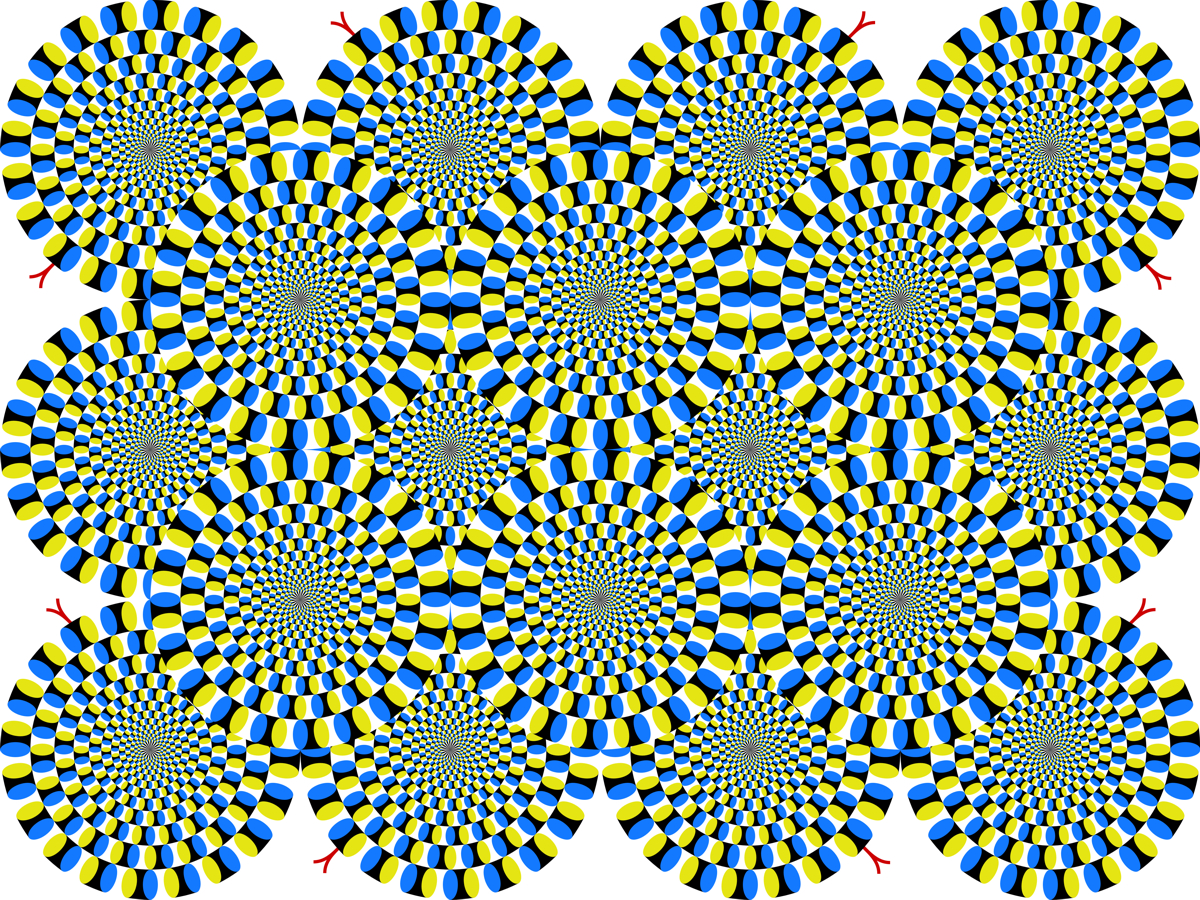
"Rotating snakes"
Each disk appears to rotate 'spontaneously' in the constant direction, from black to blue, white, yellow, back to black.
Copyright Akiyoshi Kitaoka 2003 (September 2) (updated February 16, 2013)
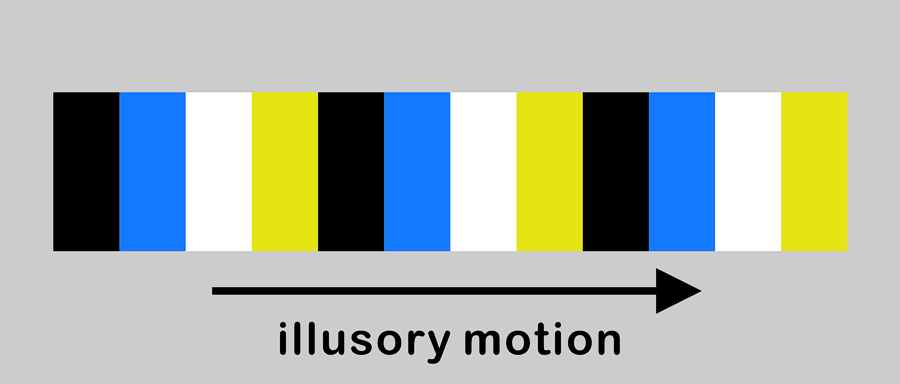
Color is not indispensable. Gray-scale images also work.
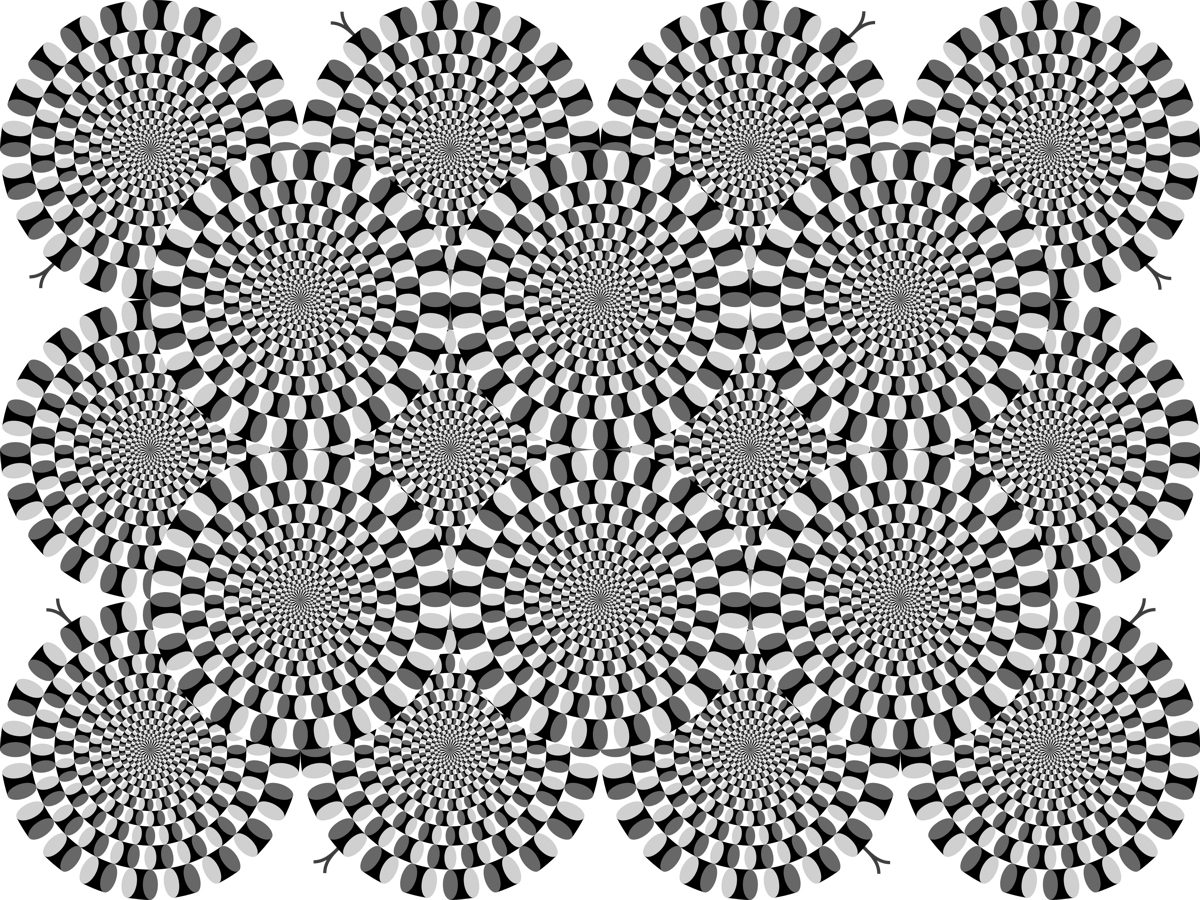
"Rotating snakes: a gray scale version"
Each disk appears to rotate 'spontaneously' in the constant direction, from black to dark gray, white, light gray, back to black.
Copyright Akiyoshi Kitaoka 2013 (May 27)
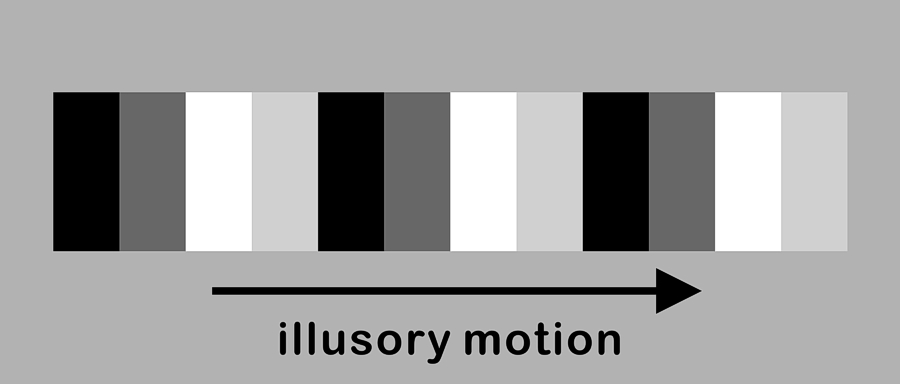
A few years ago I discovered the color-dependent motion illusion.
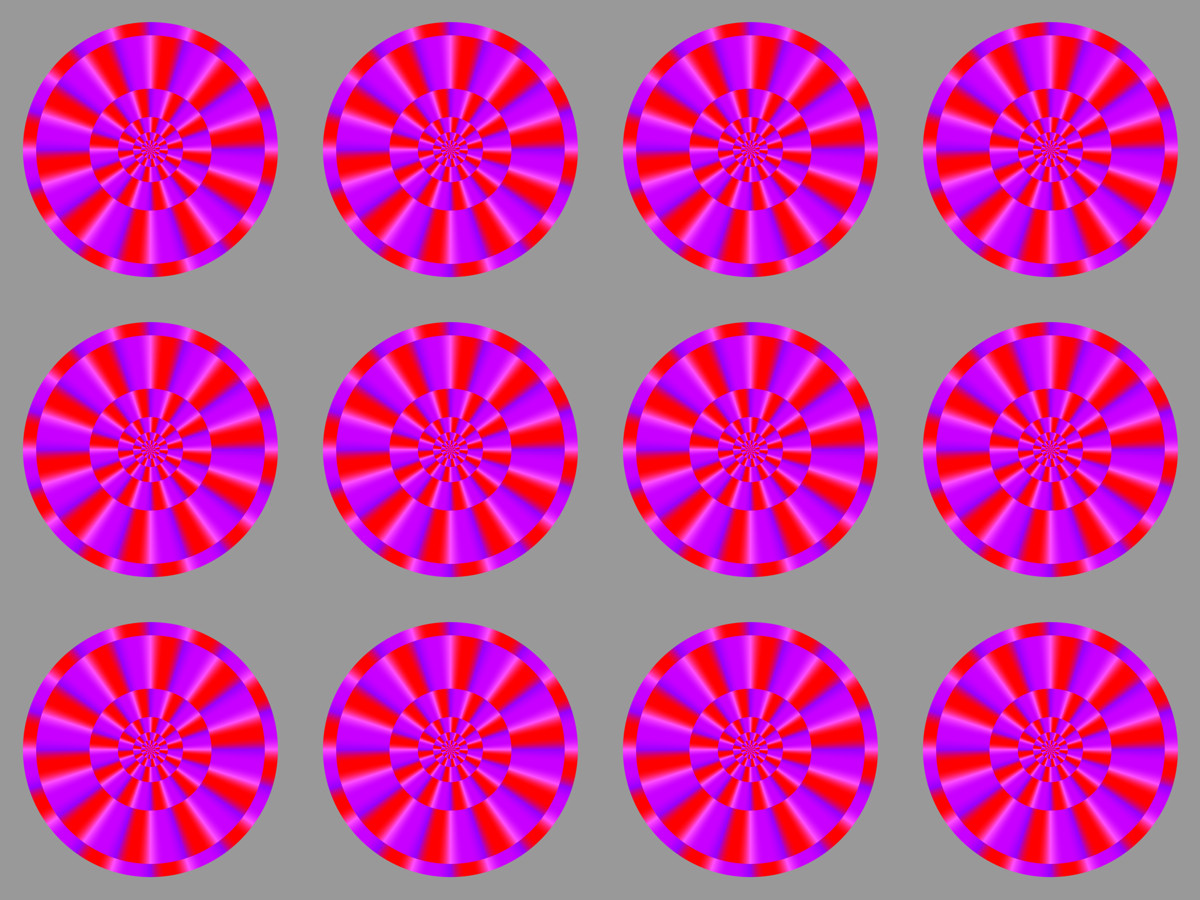
Copyright Akiyoshi Kitaoka 2013 (February 6)
Figure 6 of Kitaoka, A. (2014). Color-dependent motion illusions in stationary images and their phenomenal dimorphism. Perception, 43(9), 914-925.
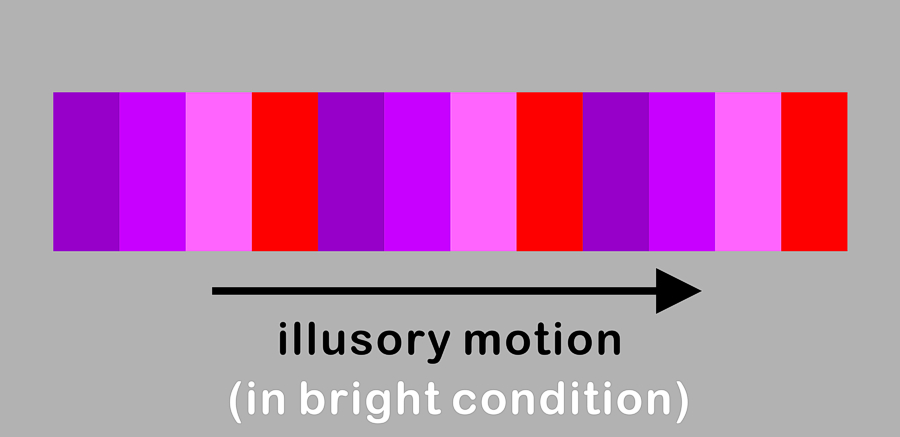
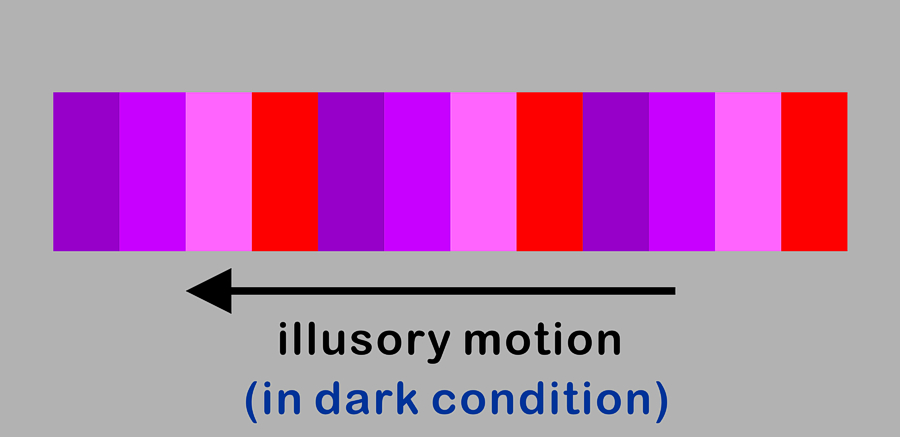
Fraser and Wilcox showed a new phenomenon that stationary disks appear to rotate. They reported bimorphism or bistability of this illusion.
1. Fraser and Wilcox (1979)
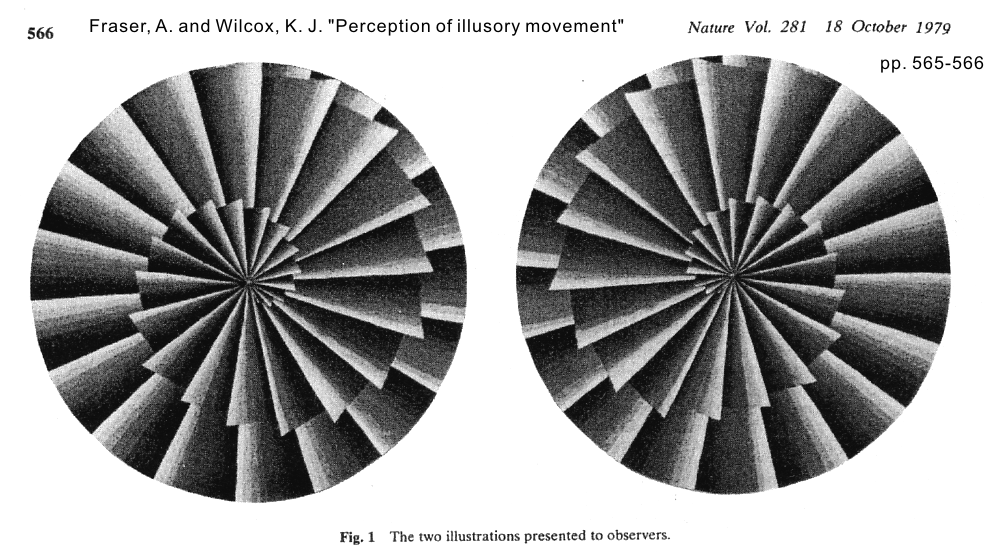
Fraser, A. and Wilcox, K. J. (1979) Perception of illusory movement. Nature, 281, 565-566.
Ambiguity in the direction of illusory rotation
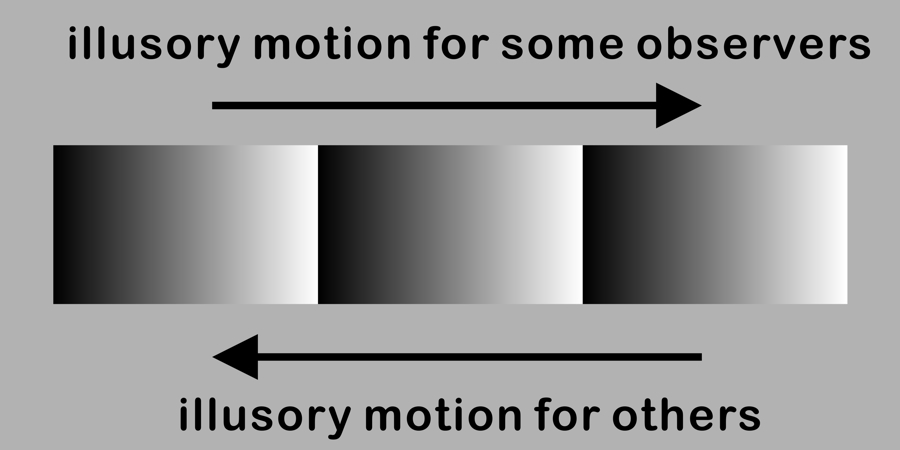
Alex Fraser was a professor of genetics and a painter!
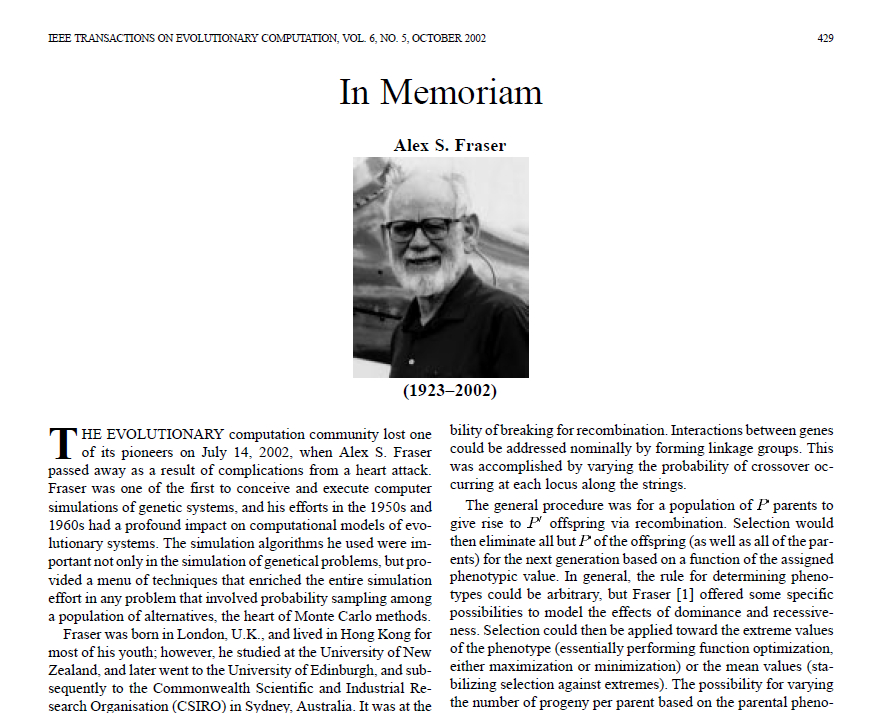
Fogel, D. B. (2002). In Memoriam: Alex S. Fraser (1923–2002). IEEE Transactions on Evolutionary Computation, 6(5), 429-430.
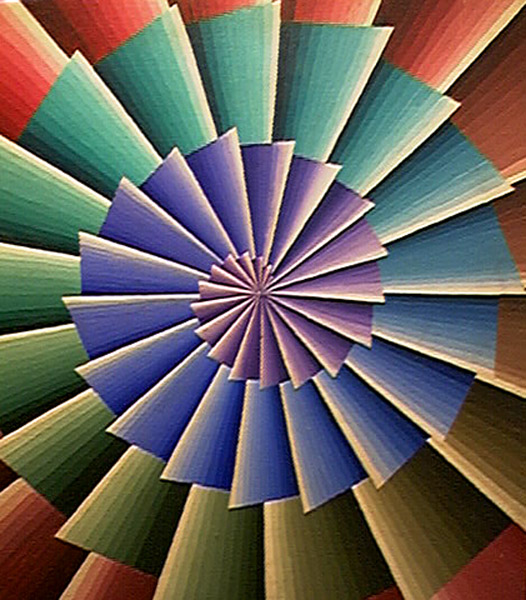
Alex Fraser's original work
Adopted with permission from Alan Fraser (2006) "Alex Fraser, Geneticist and Painter" http://doctoralexfraser.blogspot.jp/
The perceptual bimorphism proposed by Fraser and Wilcox (1979) was not replicated for subsequent two decades.
2. Faubert and Herbert (1999)
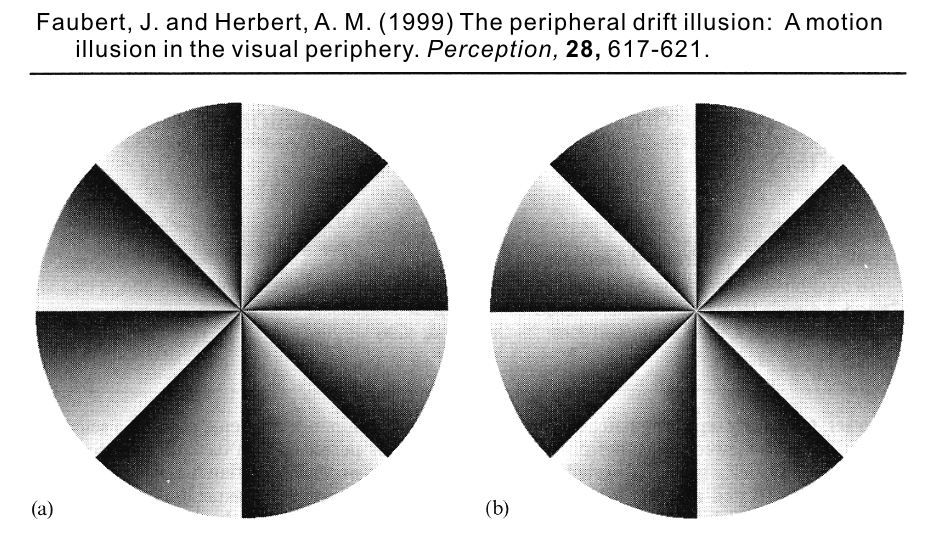
Faubert, J. and Herbert, A. M. (1999) The peripheral drift illusion: A motion illusion in the visual periphery. Perception, 28, 617-621.
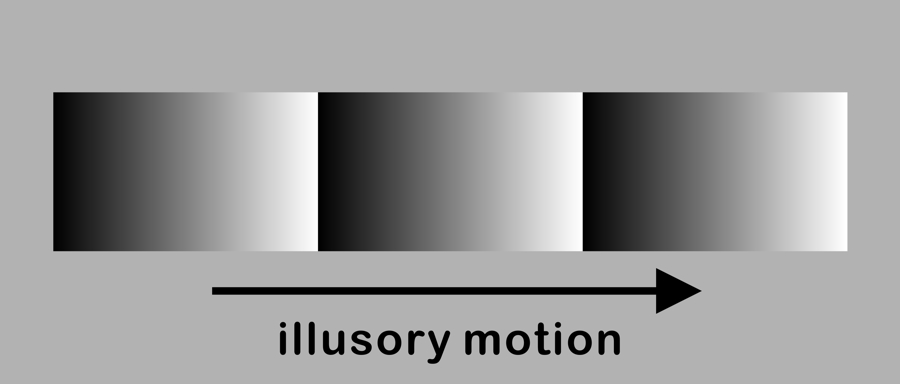
3. Naor-Raz and Sekuler (2000)
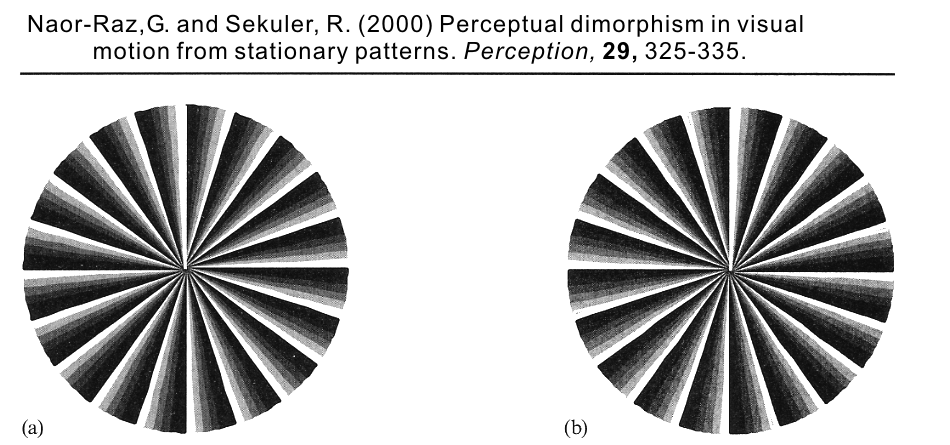
Naor-Raz, G. and Sekuler, R. (2000) Perceptual dimorphism in visual motion from stationary patterns. Perception, 29, 325-335.
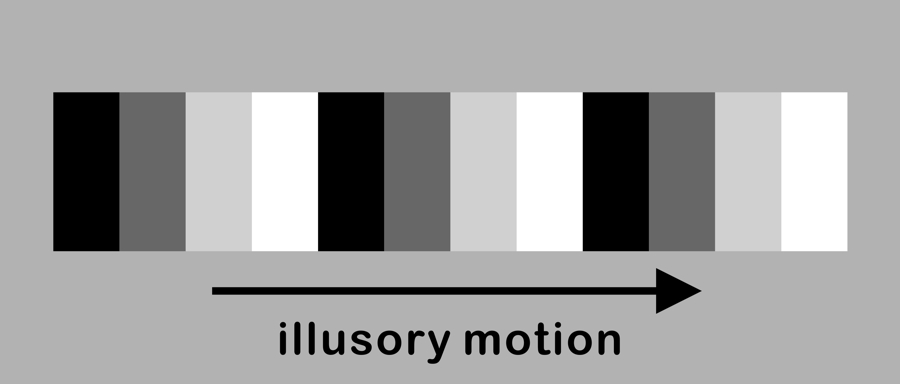
We separated two illusions that cancel each other and proposed the optimized Fraser-Wilcox illusion.
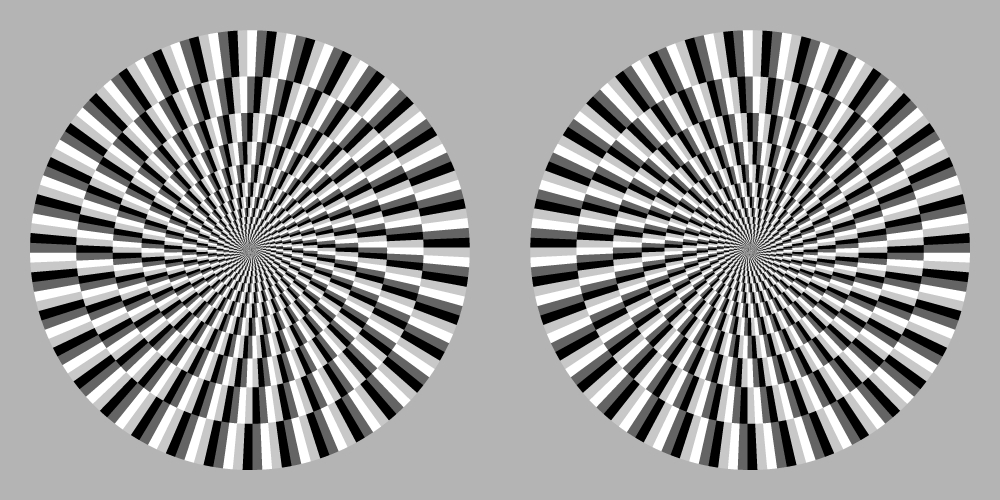
Kitaoka, A. and Ashida, H. (2003) Phenomenal characteristics of the peripheral drift illusion. VISION (Journal of the Vision Society of Japan), 15, 261-262. PDF

Two illusion are cooperatively combined.
There are a few types of the optimized Fraser-Wilcox illusion.
Luminance gradient type (Type I)

The left disk appears to rotate counterclockwise while the right one clockwise.
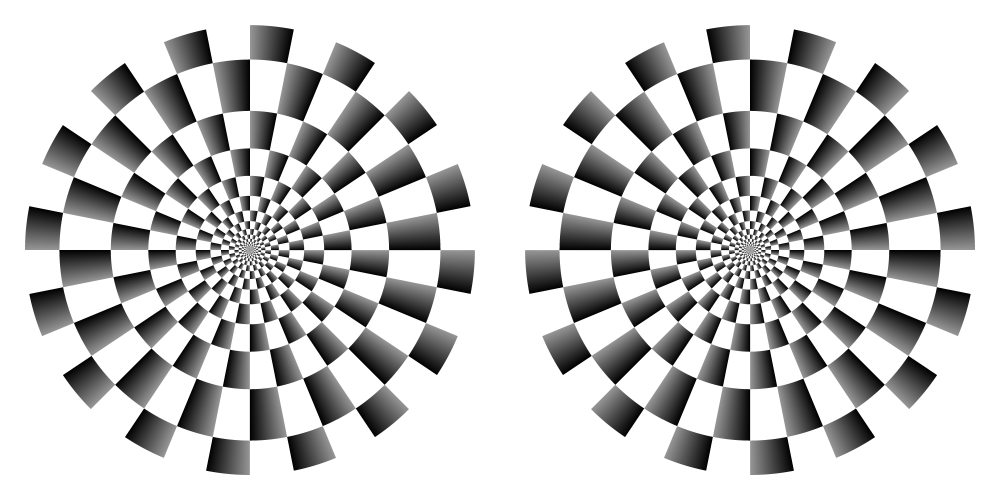
"Dark to light"
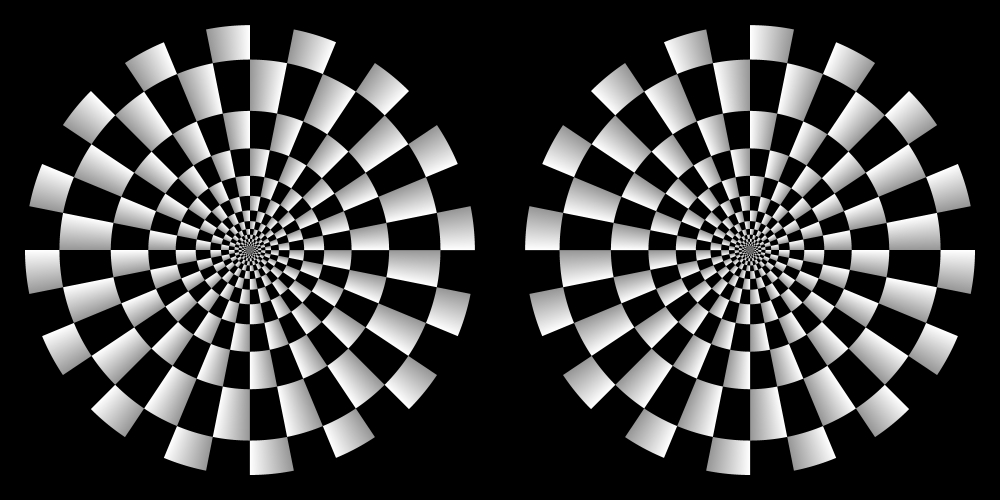
"Light to dark"
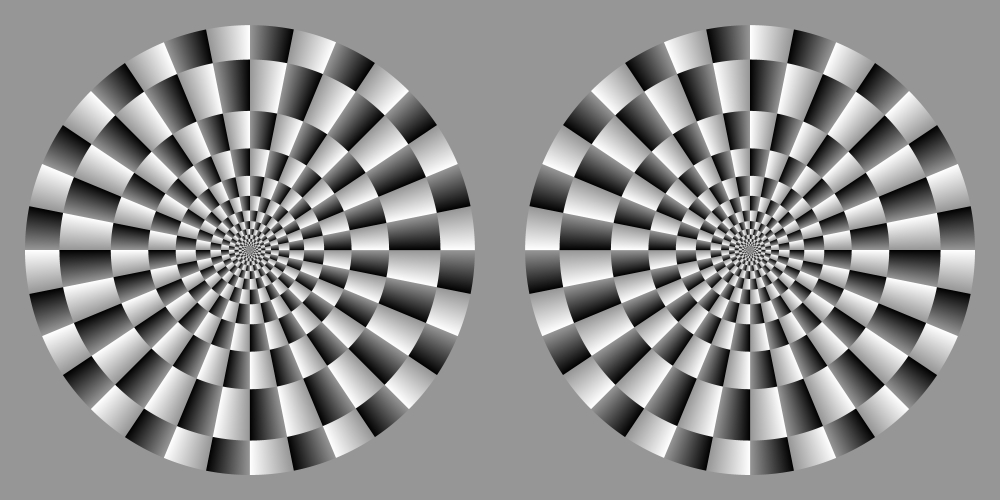
"Dark to light" and "Light to dark"
are combined, giving a stronger illusion
Color enhances illusion.
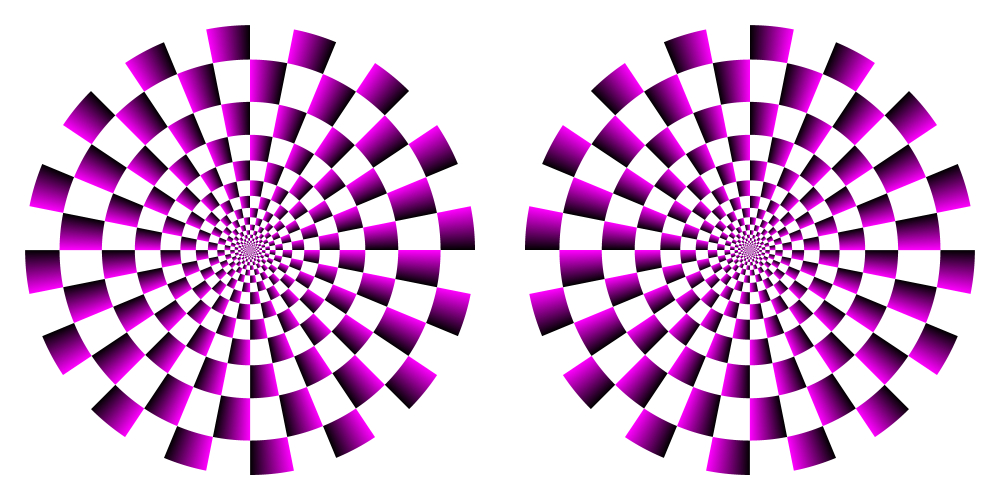
The illusion from dark to light is enhanced by red or blue.
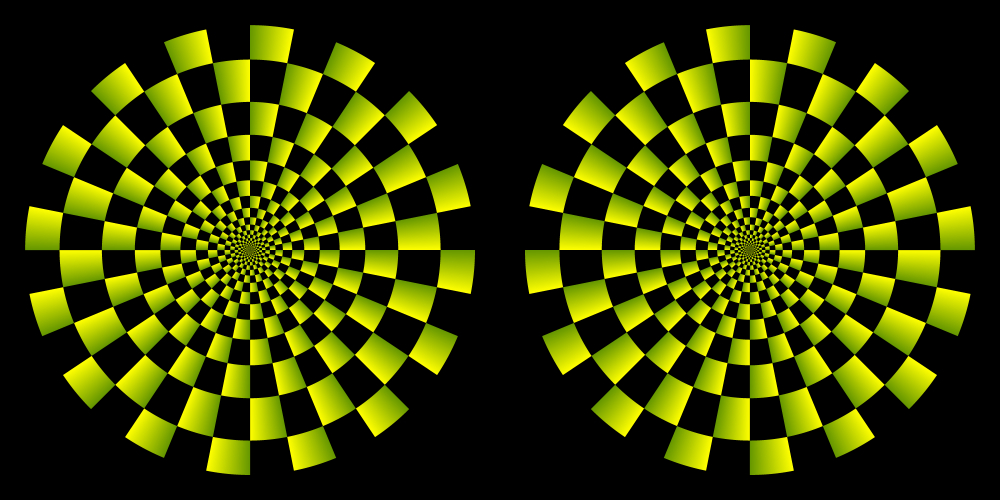
The illusion
from light to dark is enhanced by yellow or green.
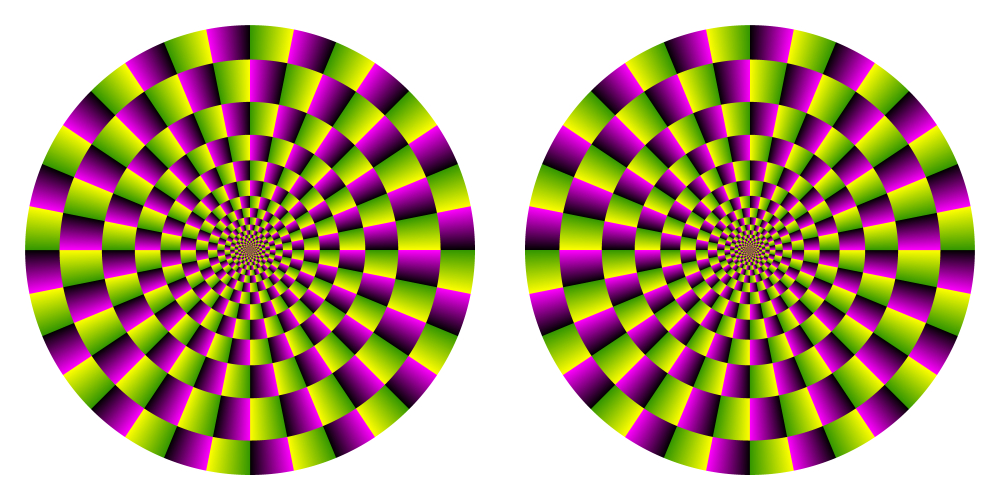
Both illusions work additively.
<Example> The upper-left, upper-right, and lower-middle disks appear
to rotate counterclockwise while the rest clockwise.
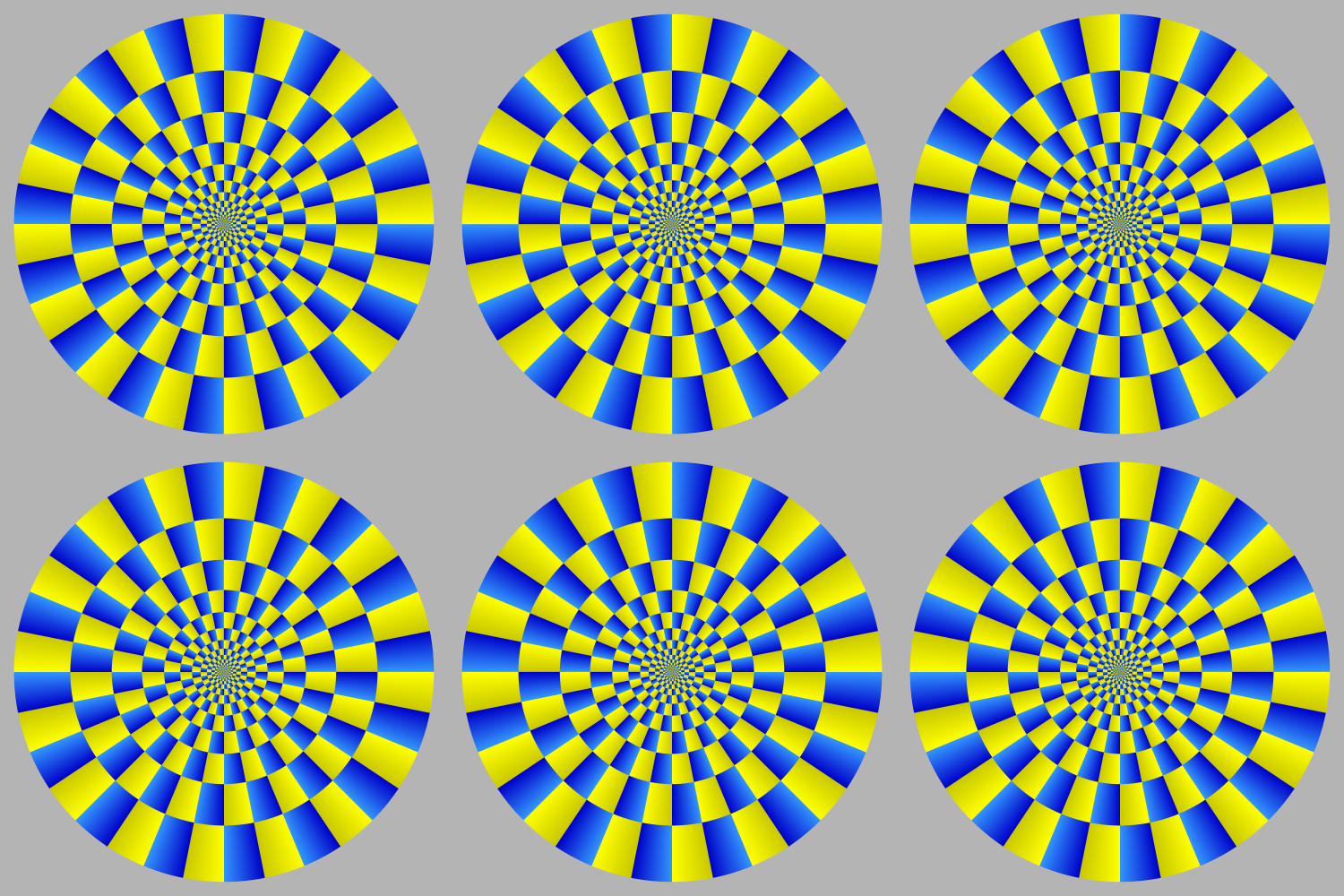
Luminance step type (Type II)
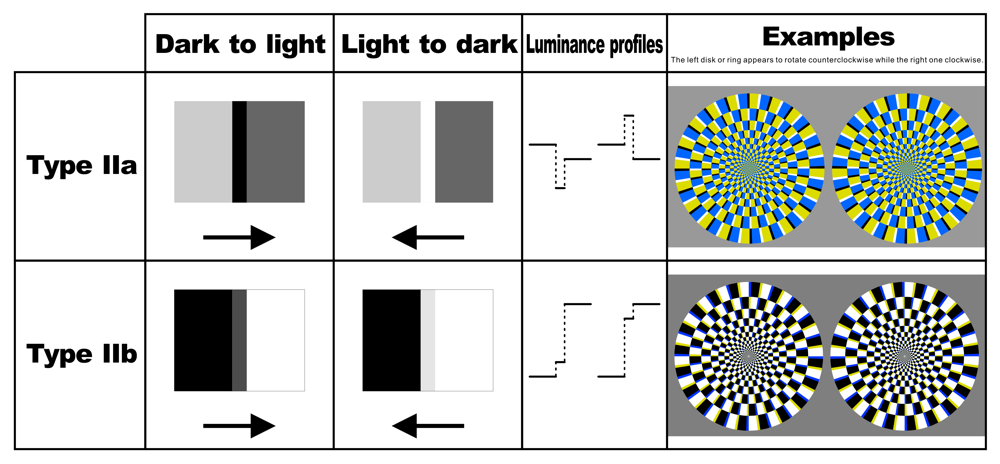
<Example> The upper-left, upper-right, and lower-middle disks appear
to rotate counterclockwise while the rest clockwise.
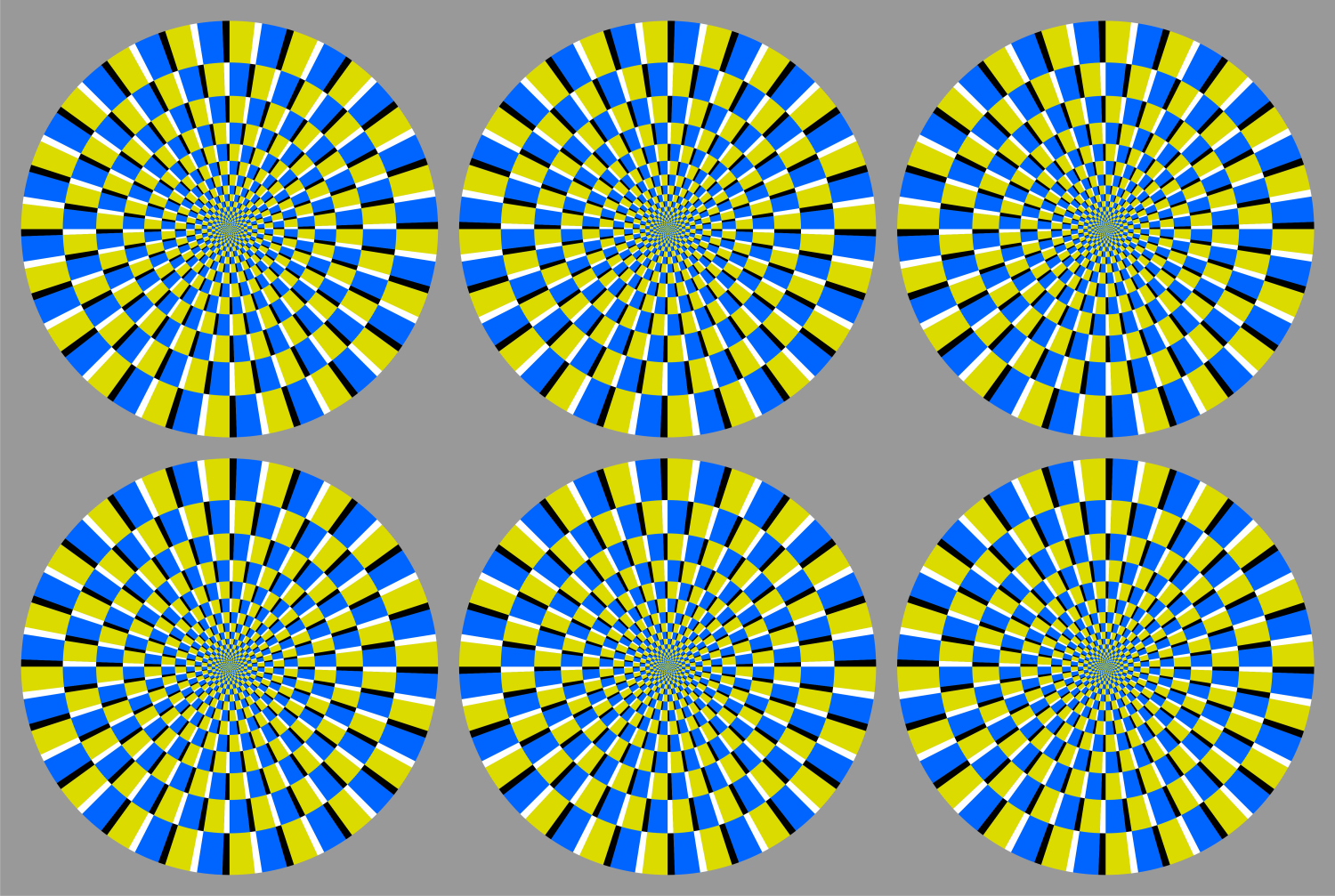
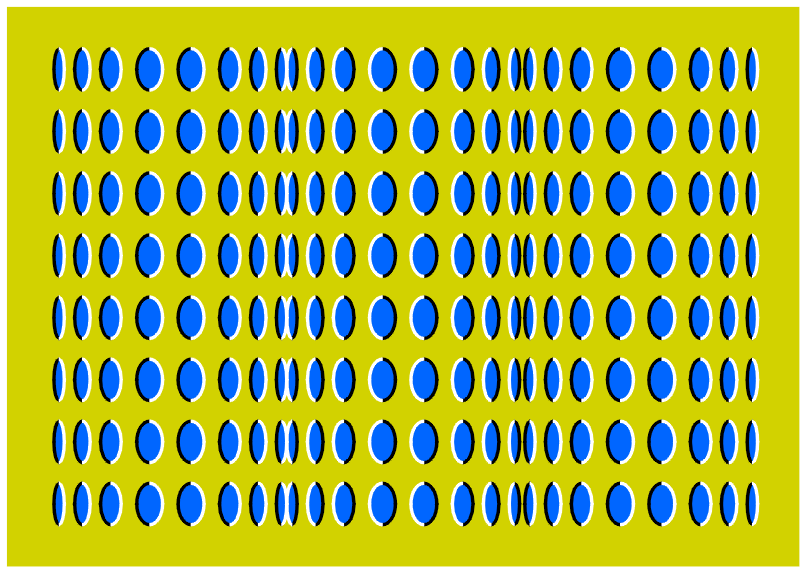
"Rollers"
Rollers appear to rotate without effort. On the other hand, they appear to rotate in the opposite direction when observers see this image keeping blinking.
Copyright A.Kitaoka 2004 (April 20)
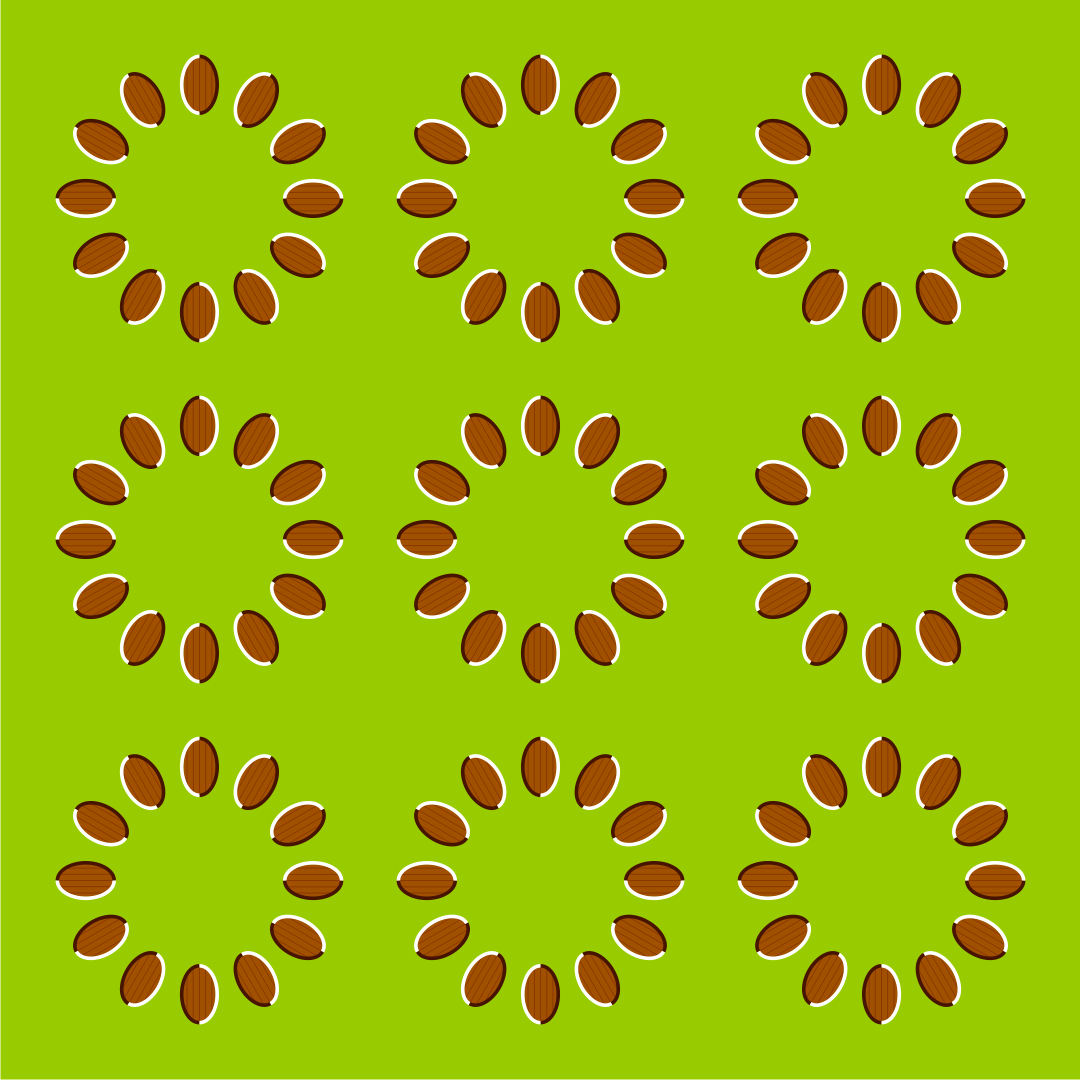
"Dongururin"*
*Rotation of donguri (acorns). "Gururin" means rotation.
Rings of donguri appear to rotate.
Copyright A.Kitaoka 2003 (July 3, 2003)

"Rotating snakes"
Each disk appears to rotate 'spontaneously' in the constant direction, from black to blue, white, yellow, back to black.
Copyright Akiyoshi Kitaoka 2003 (September 2) (updated February 16, 2013)
Age and illusion
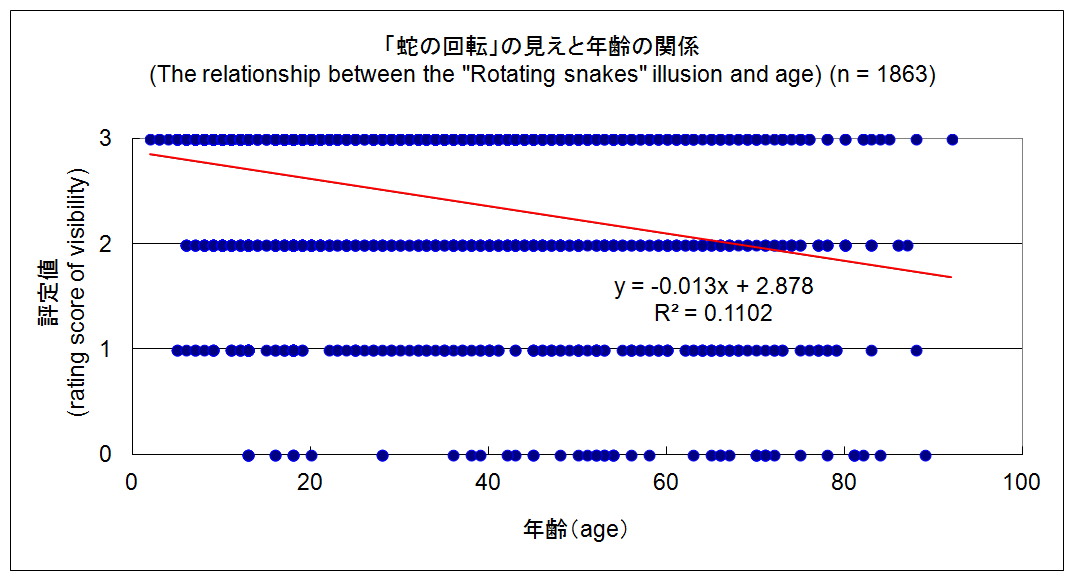
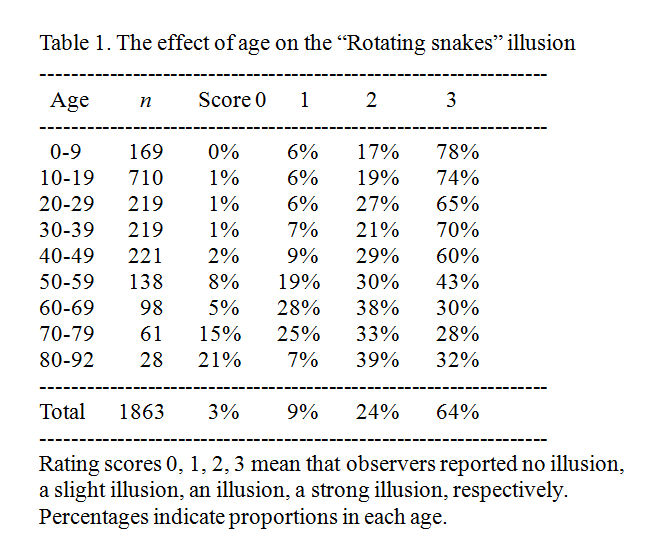
Another luminance step type (Type III)

<Example> The upper-left, upper-right, and lower-middle disks appear
to rotate counterclockwise while the rest clockwise.
.jpg)
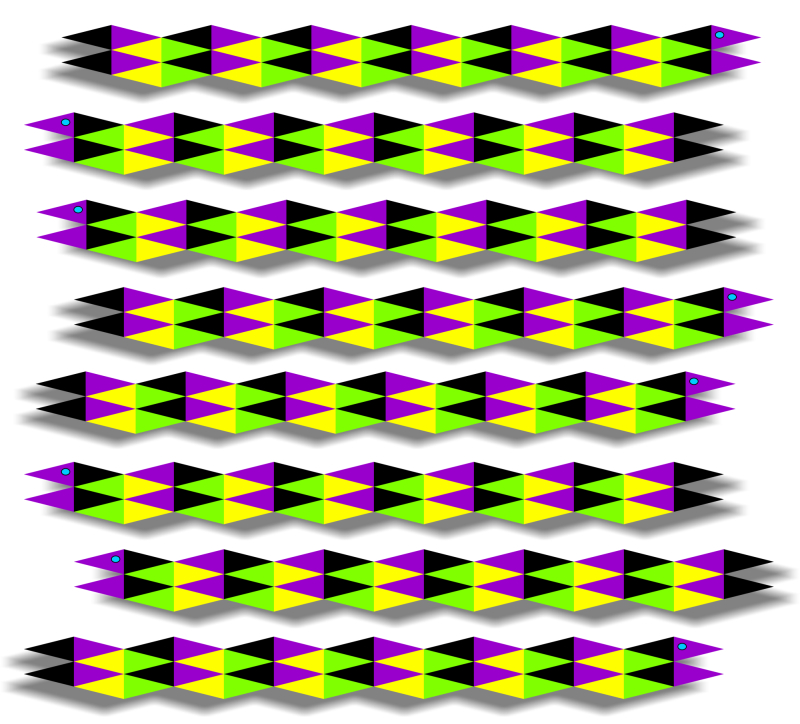
"Moving snakes with shadows"
Snakes appear to move horizontally.
Copyright Akiyoshi Kitaoka 2009 (June 7)
Highlight and shadow type (Type IV)

<Example> The upper-left, upper-right, and lower-middle disks appear
to rotate counterclockwise while the rest clockwise.
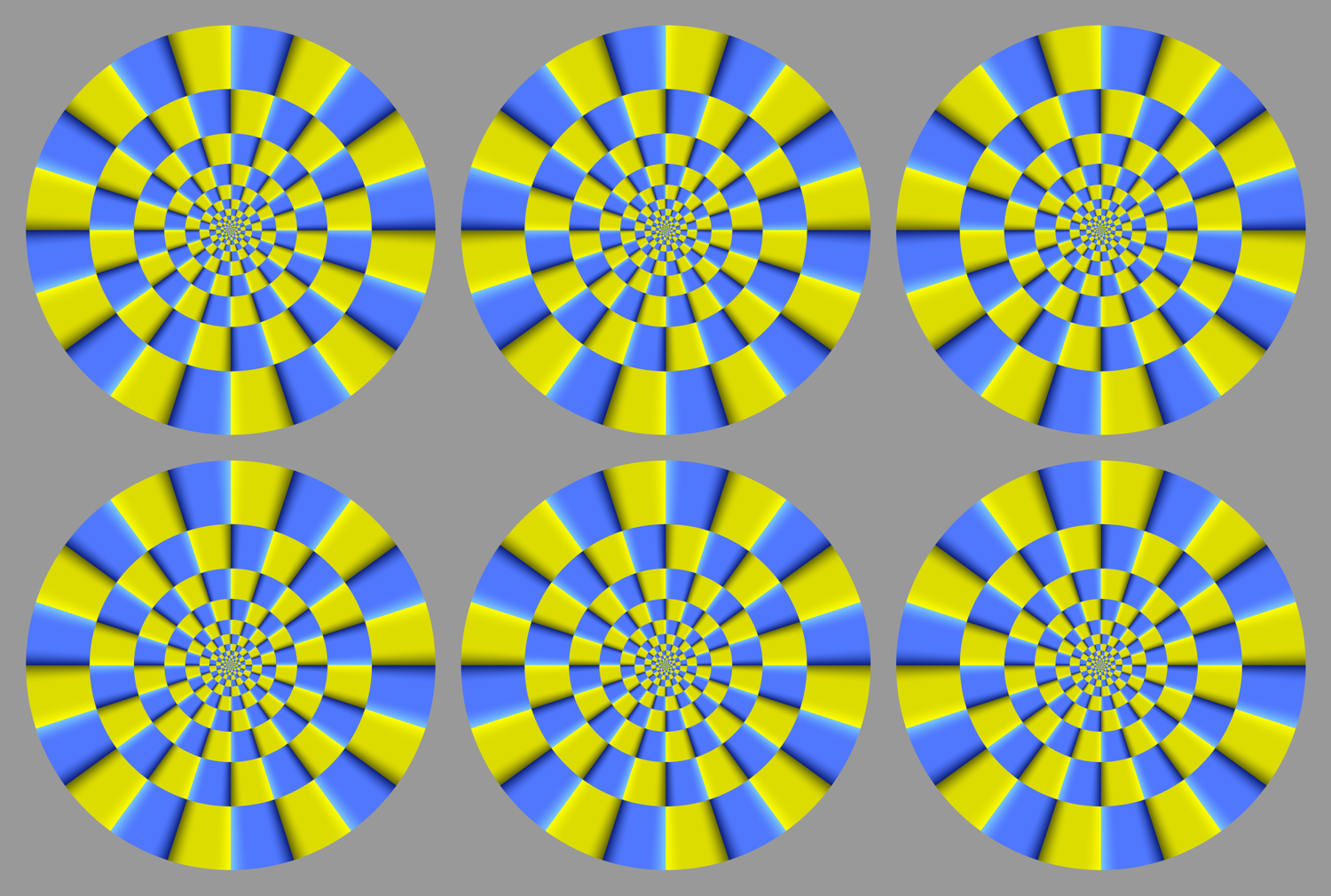
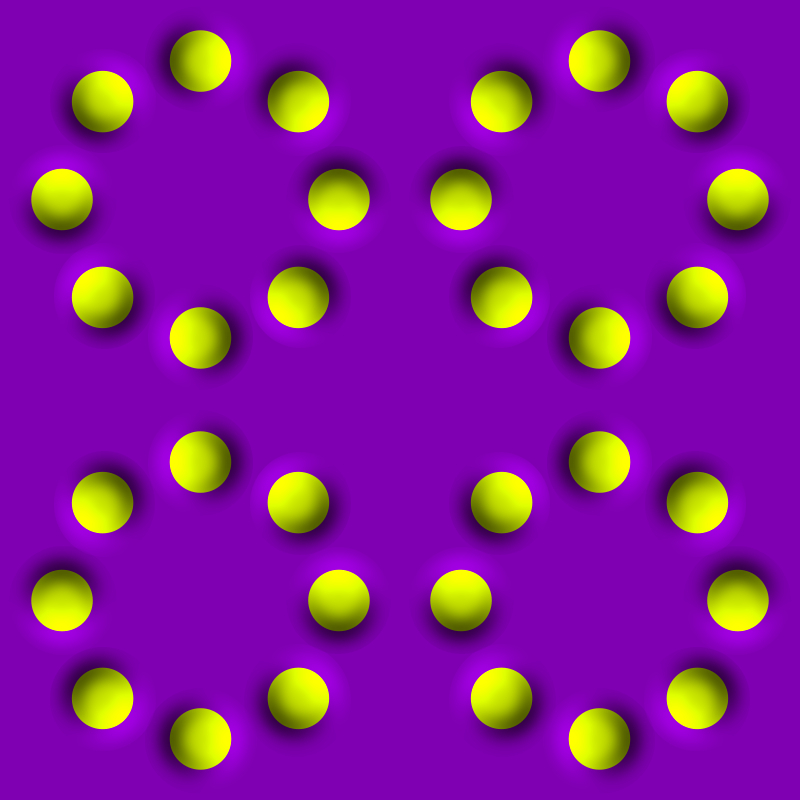
"Rotating tablets"
Rings appear to rotate.
Copyright Akiyoshi Kitaoka 2011 (July 14)
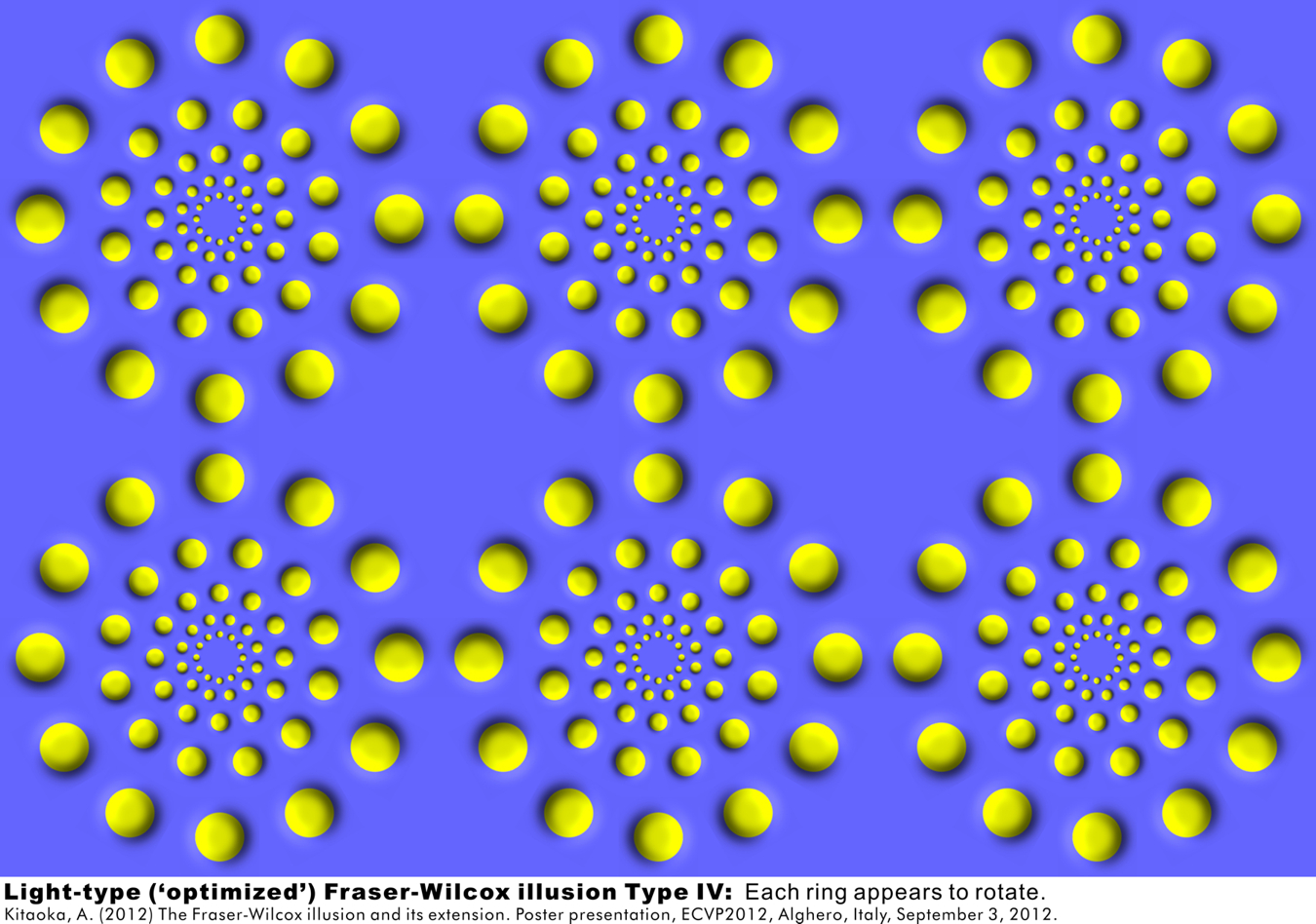
Dark type
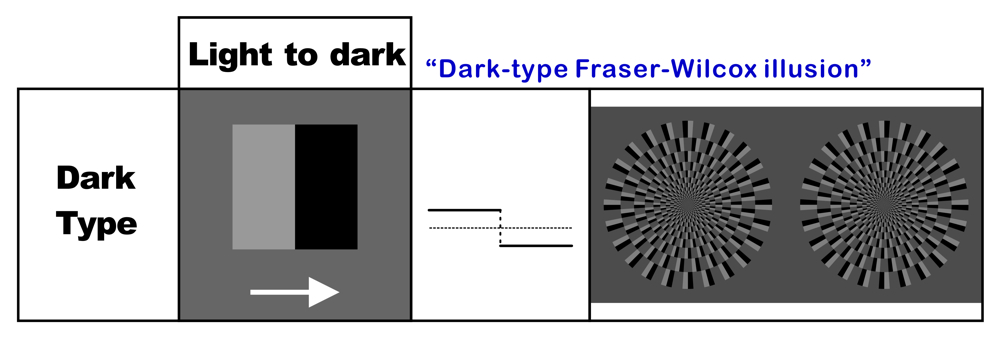
<Example> The upper-left, upper-right, and lower-middle disks appear
to rotate counterclockwise while the rest clockwise.
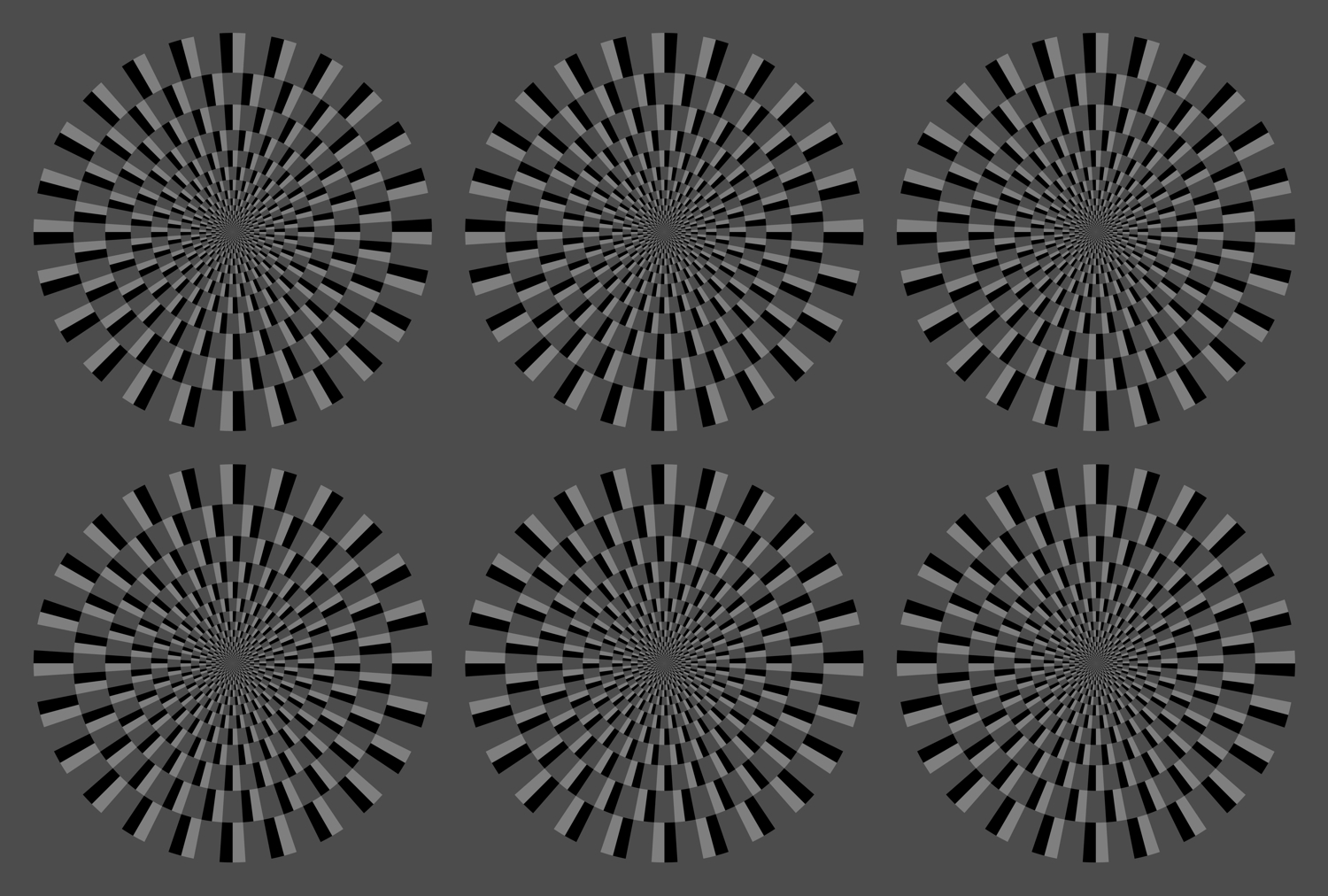
Kitaoka, A. (2012). The Fraser-Wilcox illusion and its extension. Perception 41 ECVP Abstract Supplement, page 91 (Poster September 3, 2012). Poster PDF
Copyright Robert Sekuler
Exception of the dark type
(kind of color-dependent type)
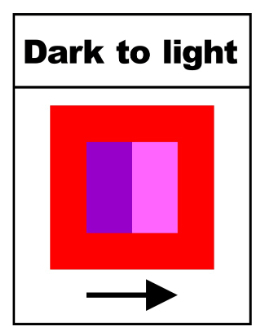
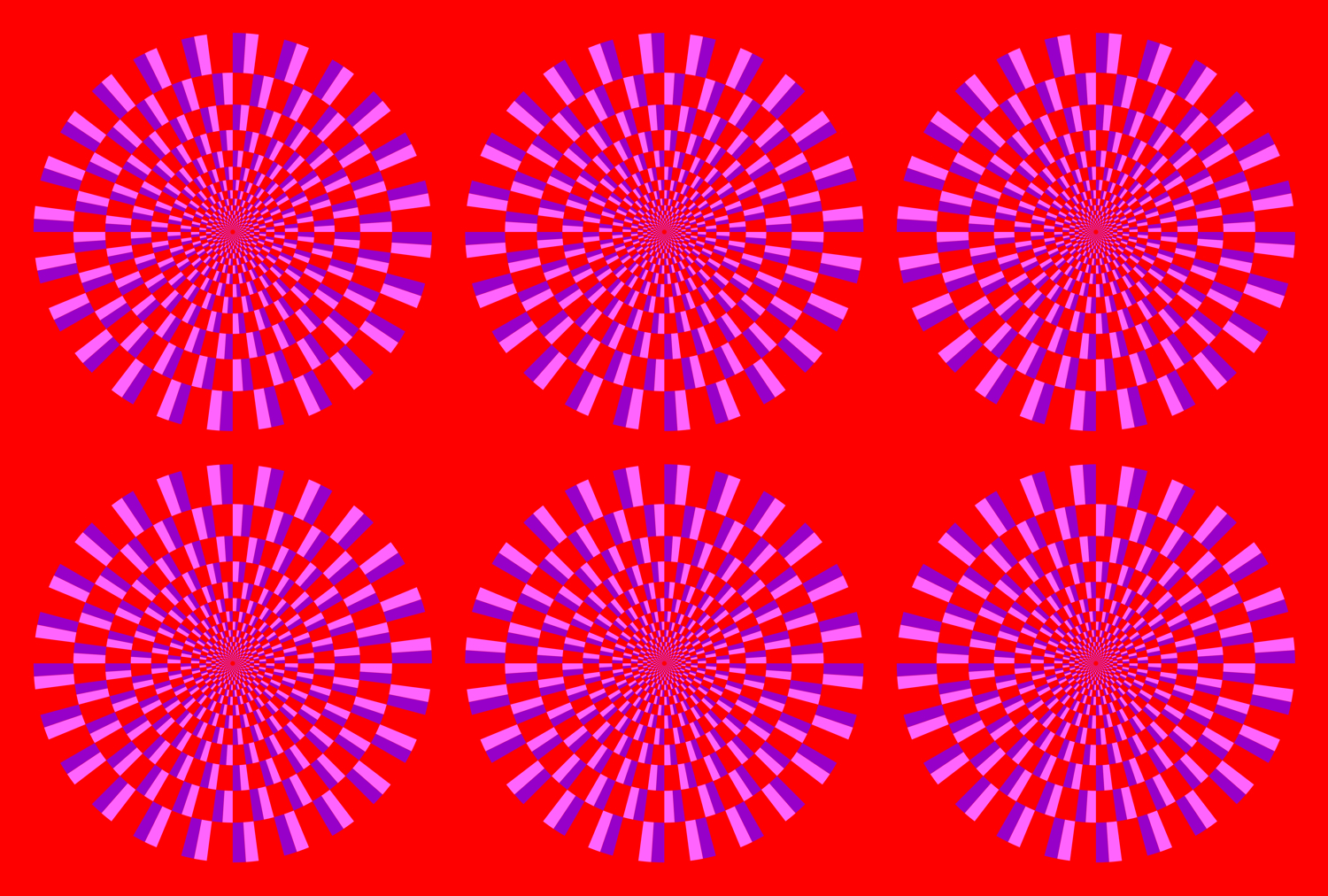
Kitaoka, A. (2012). The Fraser-Wilcox illusion and its extension. Perception 41 ECVP Abstract Supplement, page 91 (Poster September 3, 2012). Poster PDF
Color-dependent type

Kitaoka, A. (2014). Color-dependent motion illusions in stationary images and their phenomenal dimorphism. Perception, 43(9), 914-925.
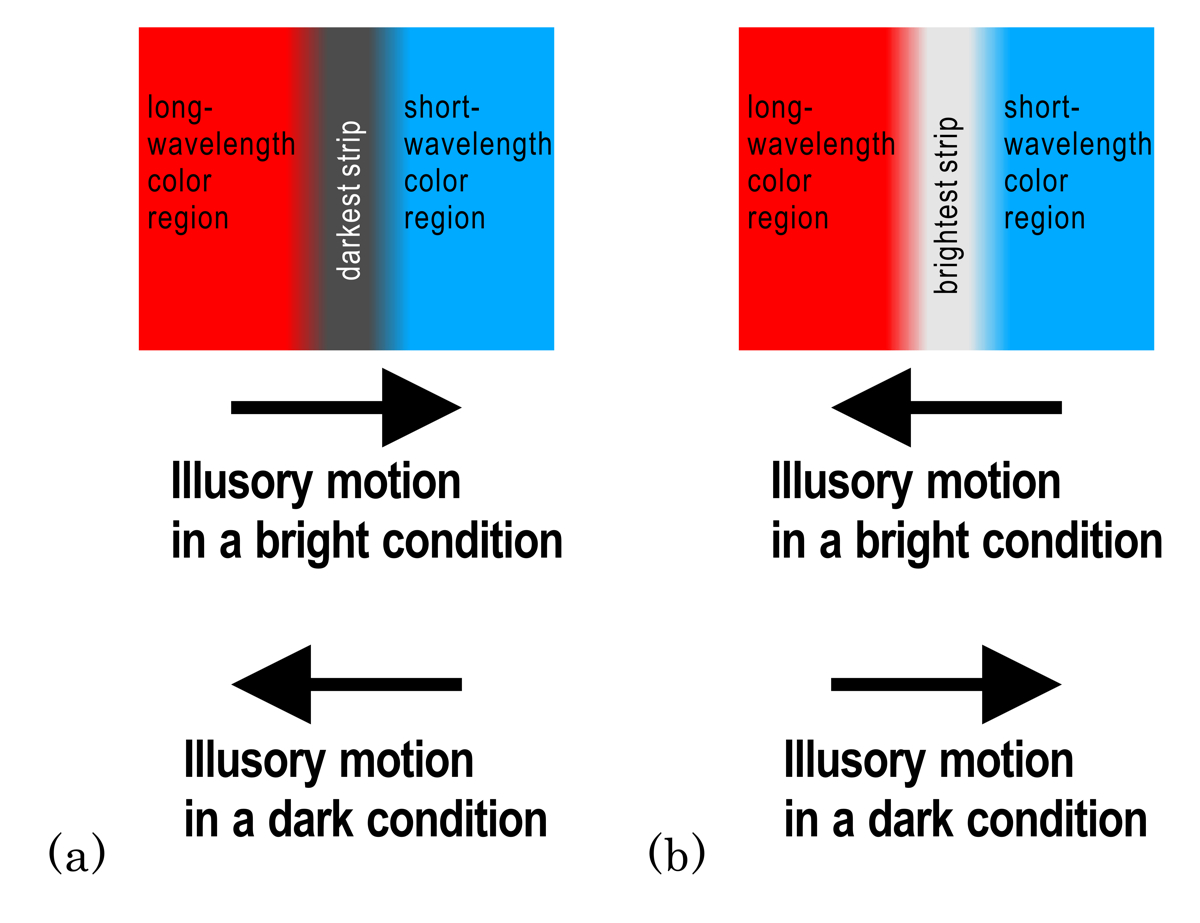
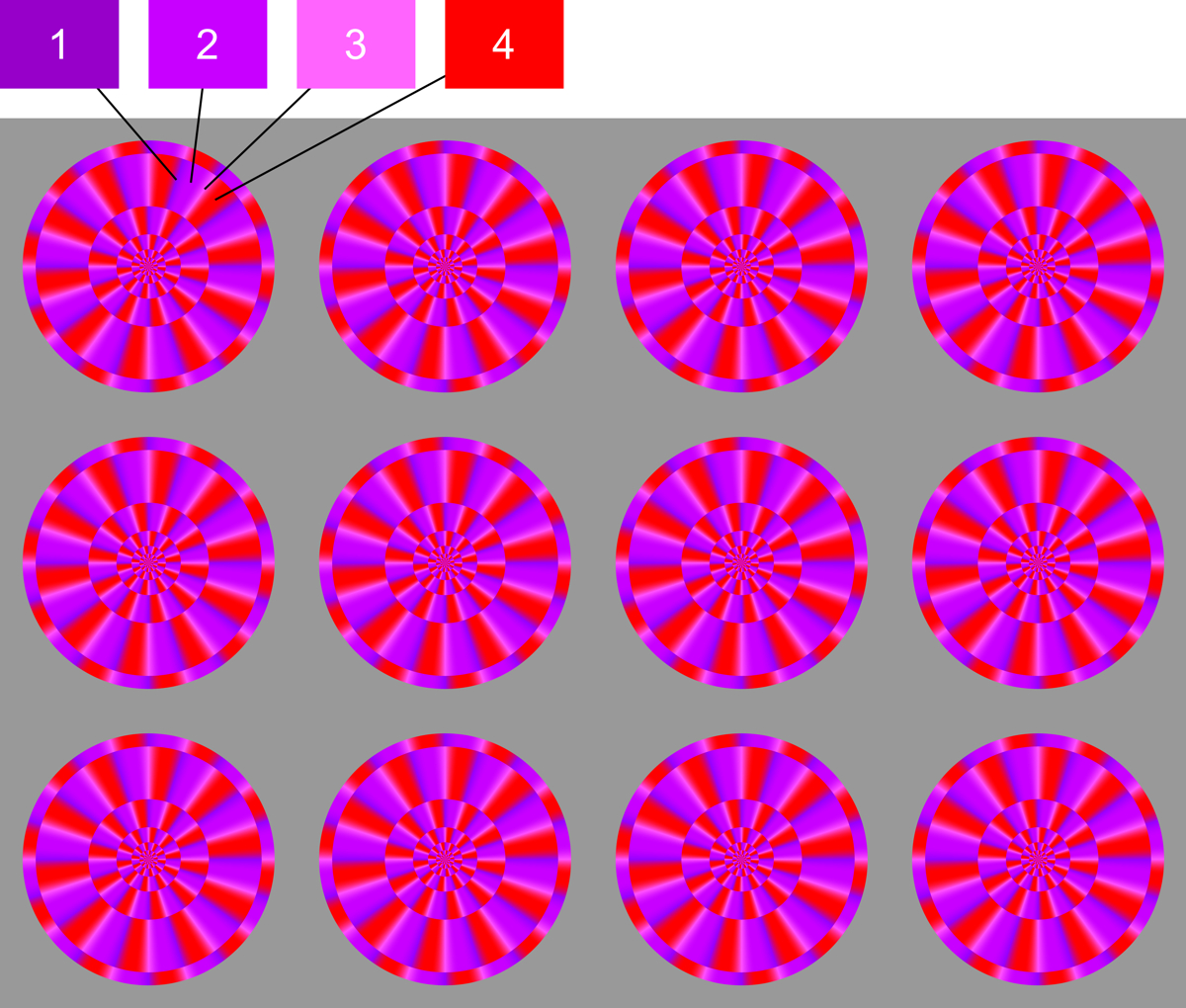
Figure 6 of Kitaoka, A. (2014). Color-dependent motion illusions in stationary
images and their phenomenal dimorphism. Perception, 43(9), 914-925.
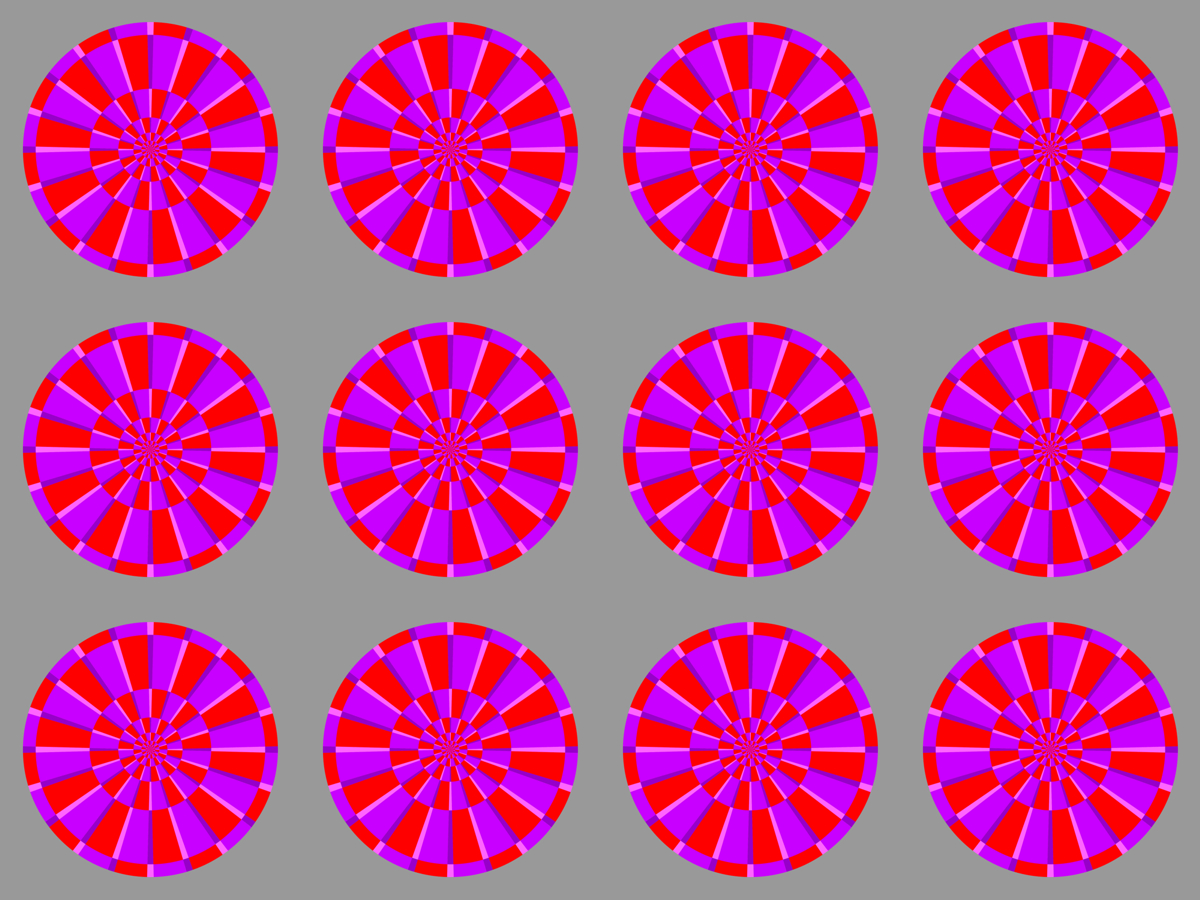
Illusion remains when the image is not blurred.
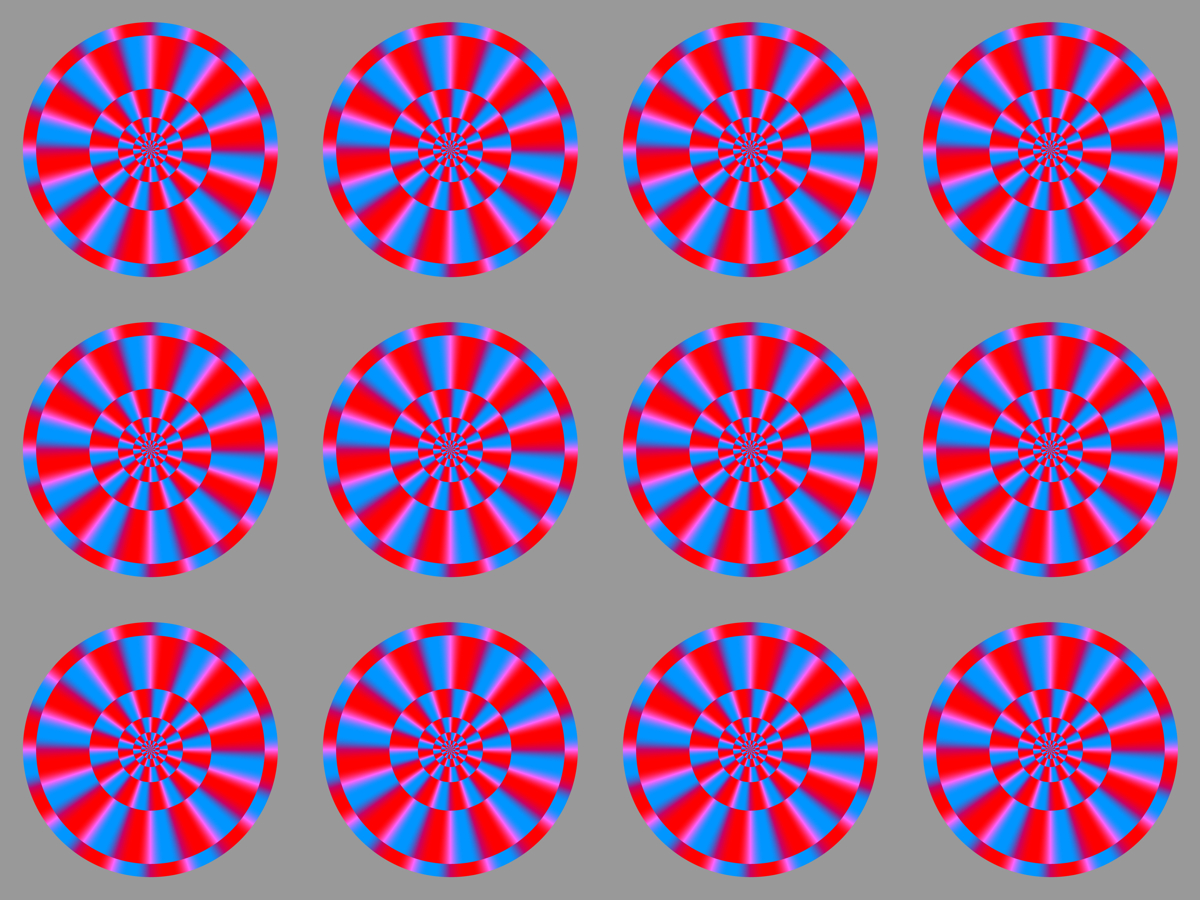
Illusion occurs with red and blue.
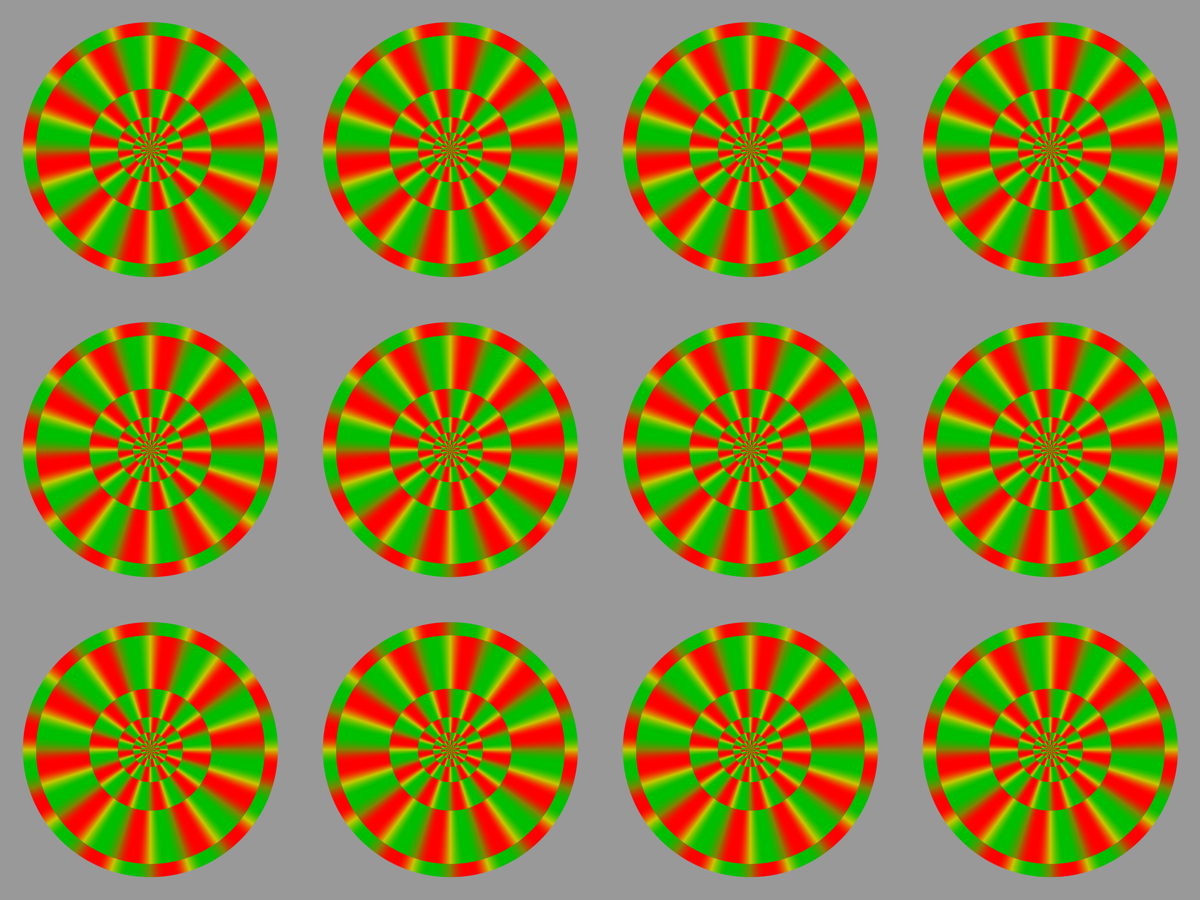
Illusion occurs with red and green.
Twitching illusion, a variation of the color-dependent type
Kitaoka, A. (2014). A new type of the color-dependent Fraser-Wilcox illusion. Perception 43 (37th) ECVP (Belgrade) Abstract Supplement, page 20 (Poster #17 August 25, 2014). Presentation (html) --- Poster (doc) --- Handout (doc) --- Illusion Night Handout (jpeg) --- Illusion Night Questionnaire (docx)
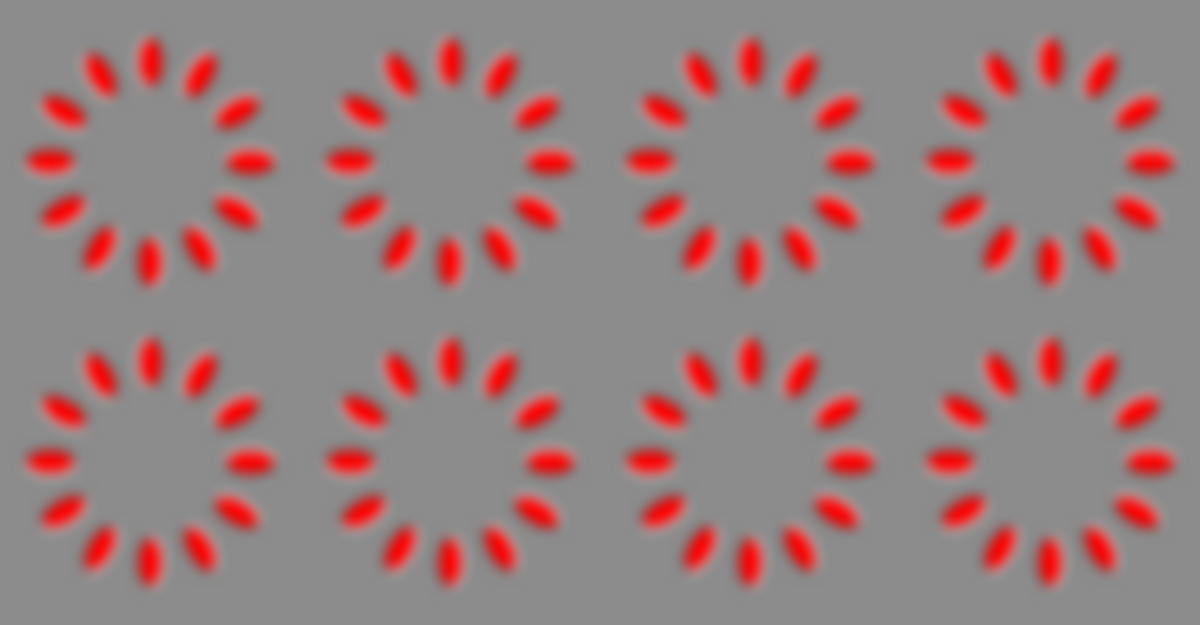
(Ellipses: R255, G0, B0; Background: R140, G140, B140)
Illusory clockwise rotation is observed.

(Ellipses: R255, G0, B0; Background: R200, G0, B255)
Illusory clockwise rotation is observed.

(Ellipses: R255, G0, B0; Background: R200, G130, B130)
Illusory clockwise rotation is observed.
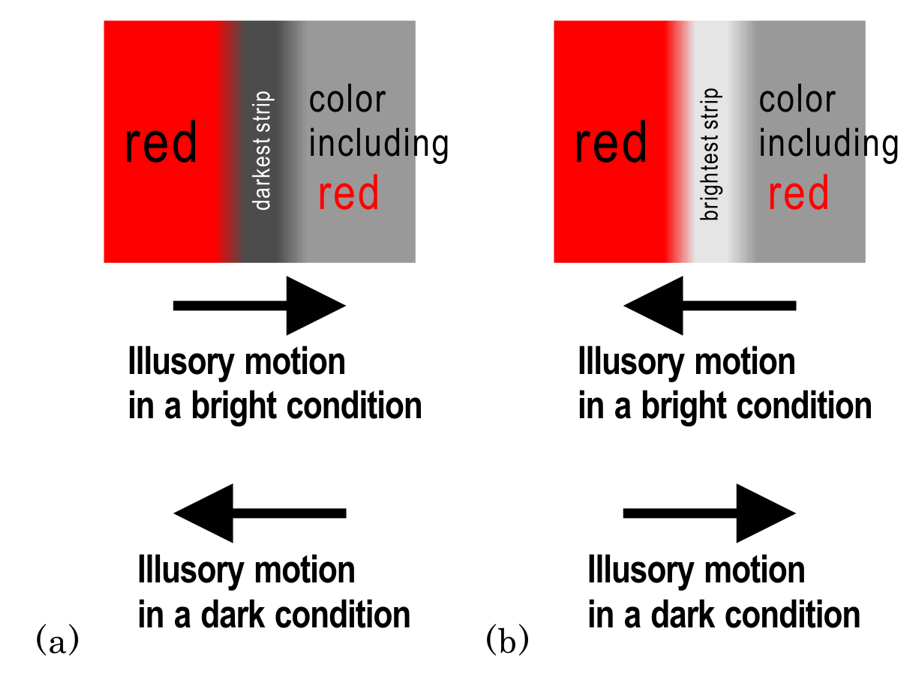
Red might play an important role in the twitching illusion.
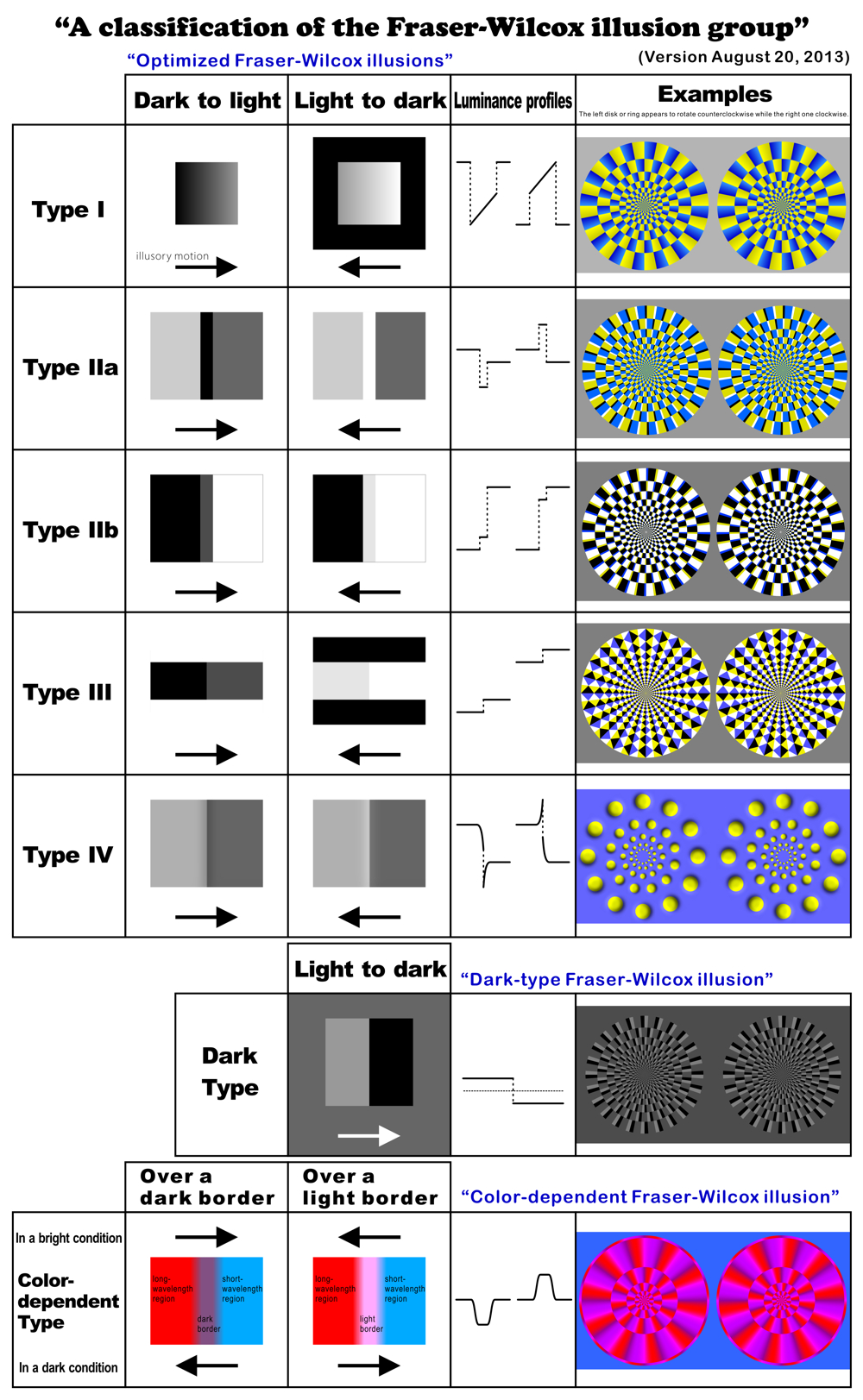
a related phenomenon
Fading-dependent motion illusion
Kitaoka, A. (2014). Motion illusion induced by color changes. 10th Asia-Pacific Conference on Vision (APCV), Sunport Takamatsu, Takamatsu, Japan, (Poster July 20, 2014 (P2-16)). Poster MS-Word doc file --- Movie demos
(GIF)
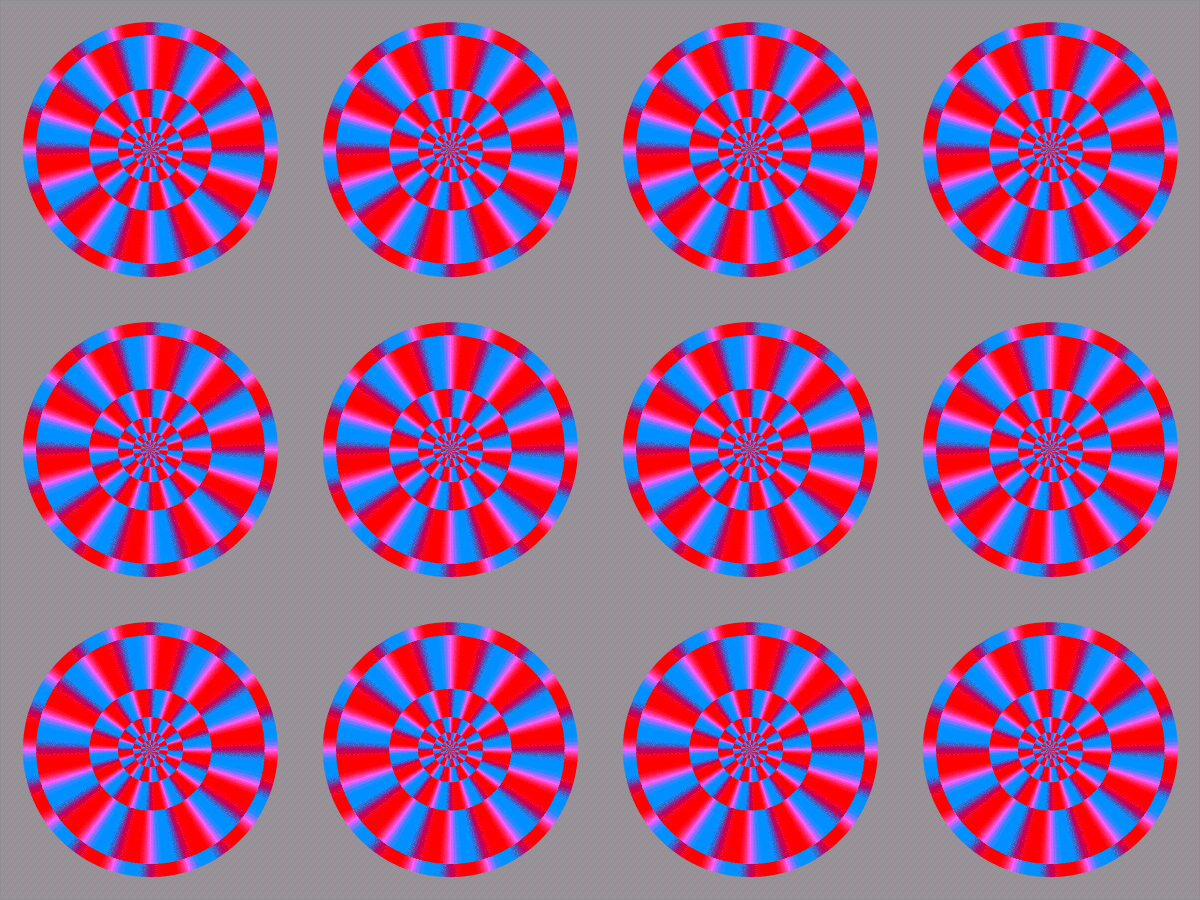
(Flash)
rotredcyandisks3-m01.swf
Each disk appears to rotate clockwise during fading-in while counterclockwise during fading-out.
Copyright Akiyoshi Kitaoka 2013 (February 19)
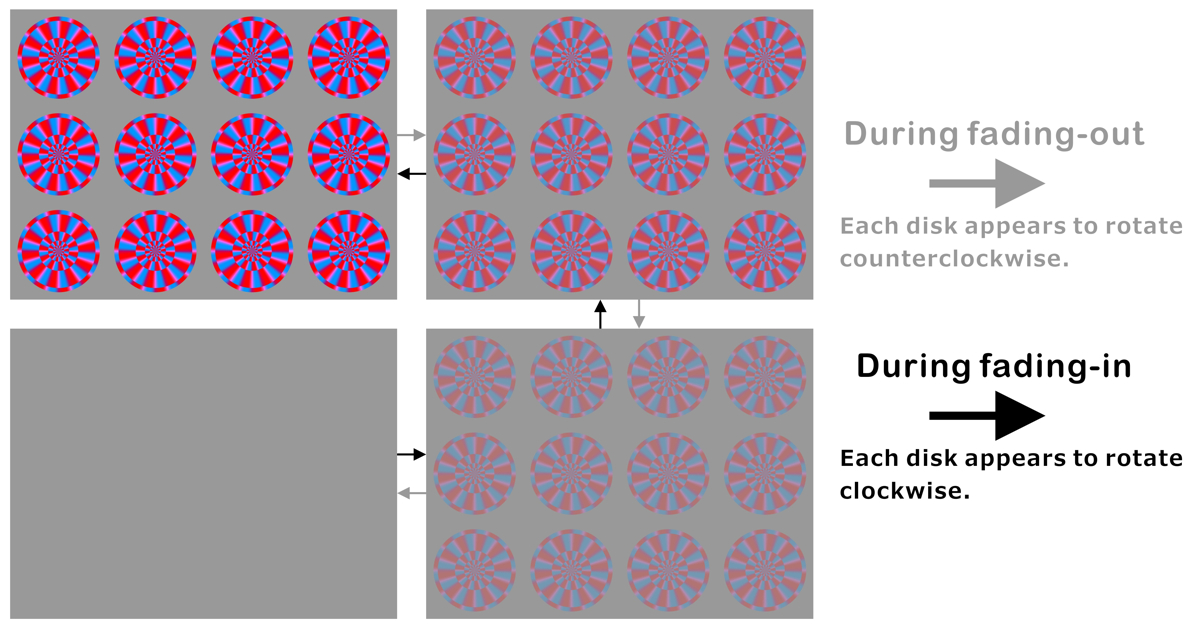
Copyright Akiyoshi Kitaoka 2014 (July 17)
Fading-dependent motion illusion depends on replacing color.
(GIF)
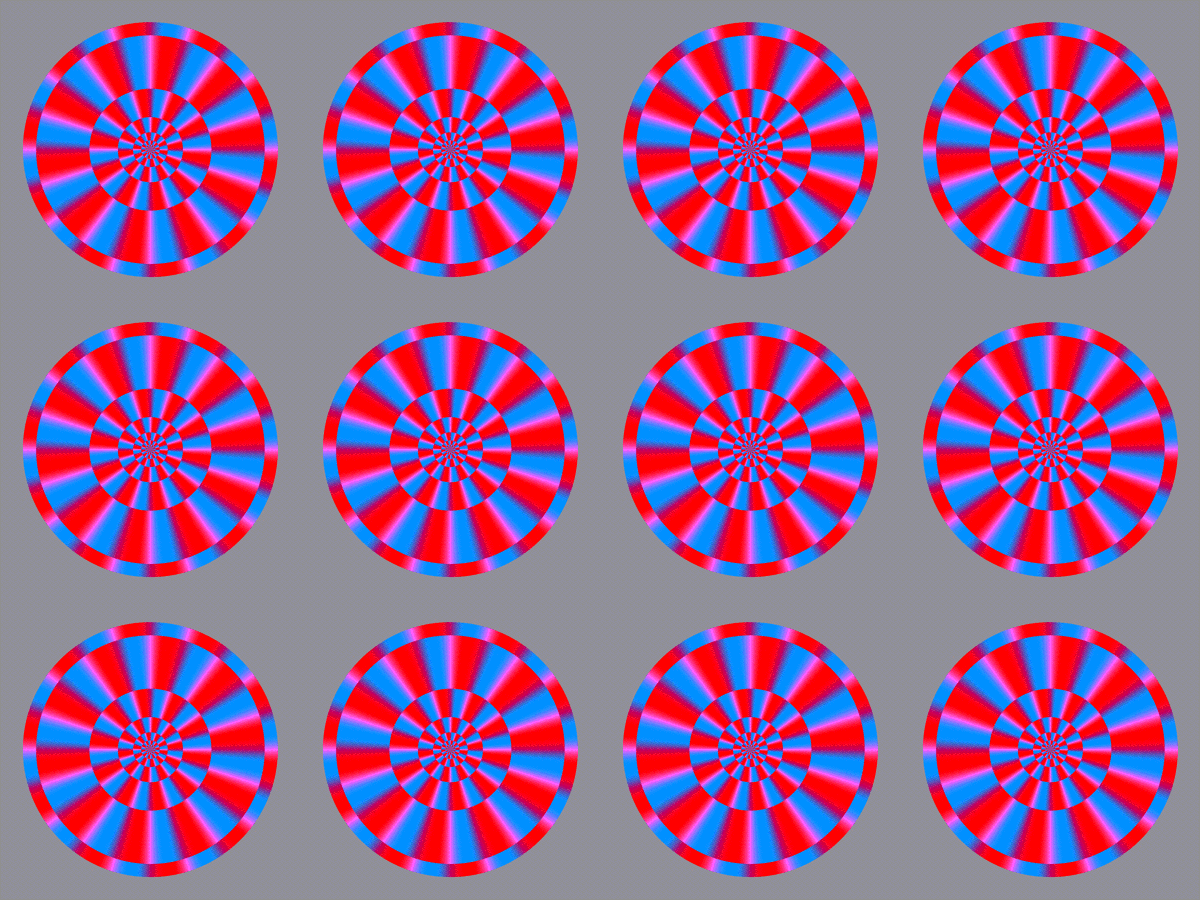
(FLASH)
rotredcyandisks3-m04.swf
(Blue RGB = 0, 150, 255)
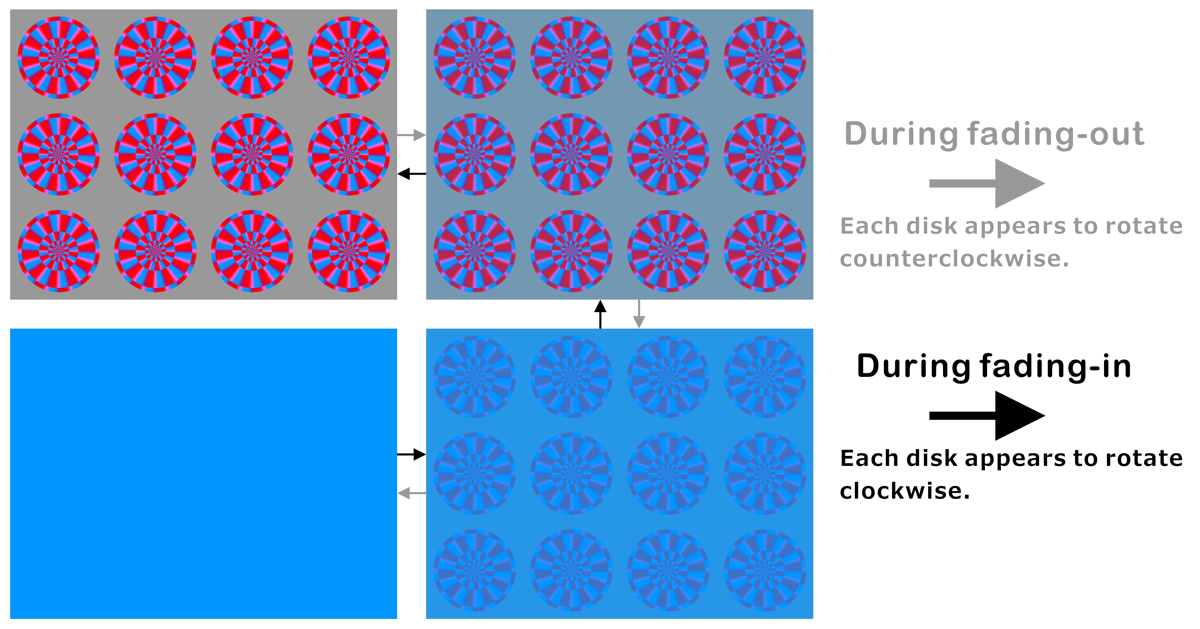
Copyright Akiyoshi Kitaoka 2014 (July 17)
Color change-dependent motion illusion #2
(GIF)
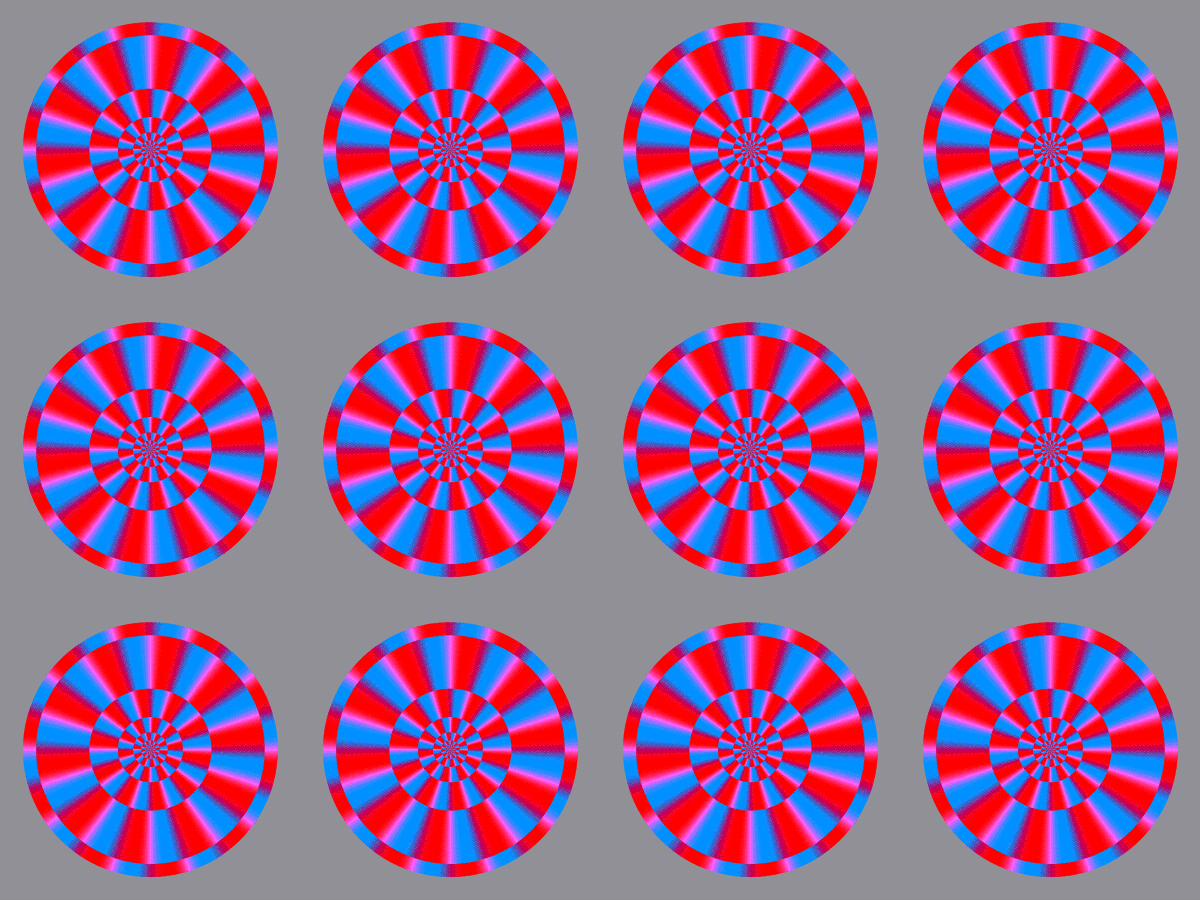
(FLASH)
rotredcyandisks3-m05.swf
(Red RGB = 255, 0, 0)
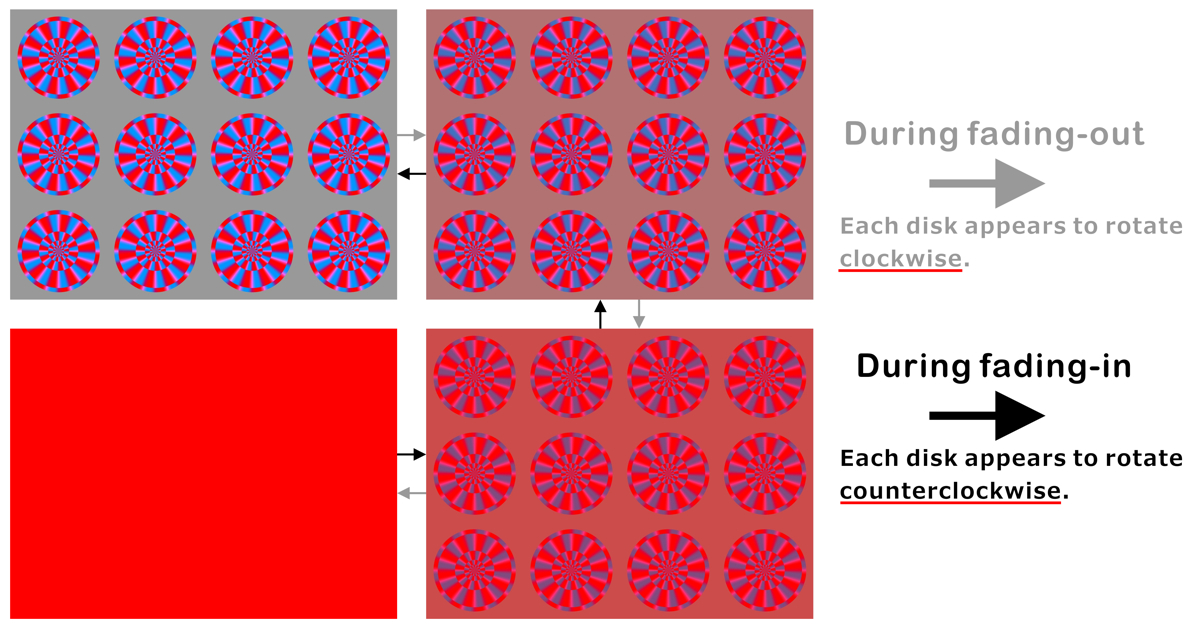
Copyright Akiyoshi Kitaoka 2014 (July 17)
(GIF)
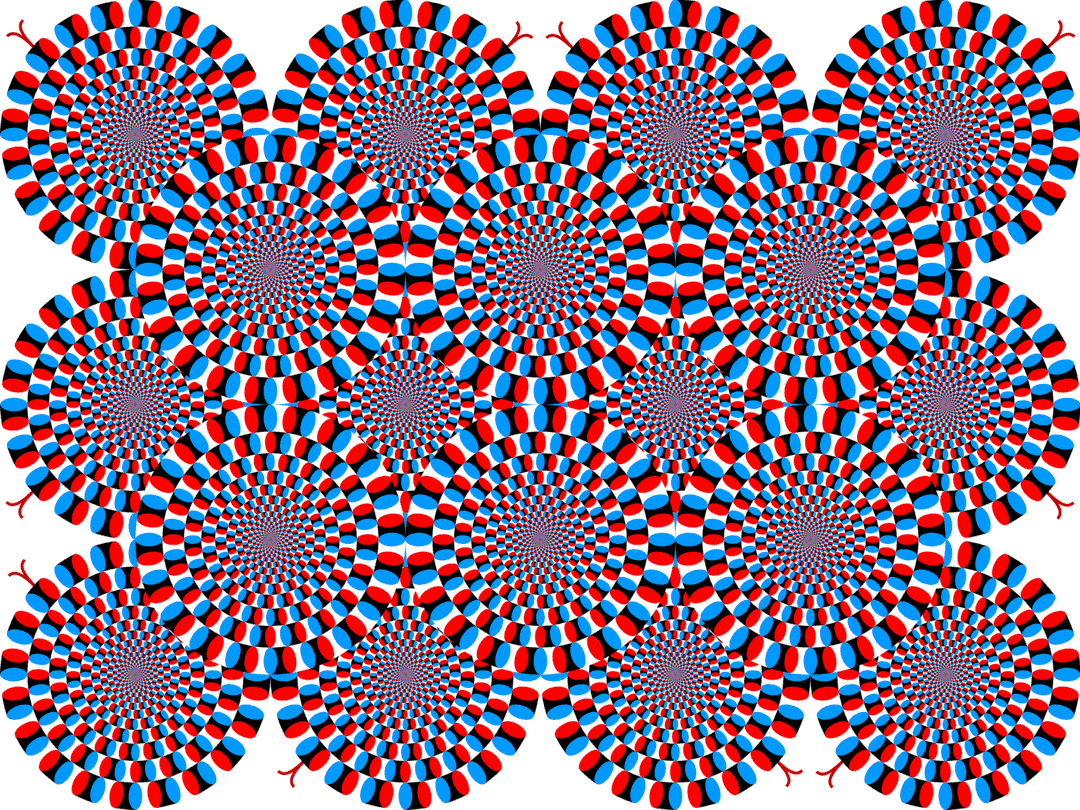
(Flash)
"On-off rotating snakes: red and sky blue #1"
When fading in, each disk appears to rotate in the direction: black, red, white, sky blue, black. The direction is reversed when fading out.
Copyright Akiyoshi Kitaoka 2013 (April 30) (GIF July 15, 2014)
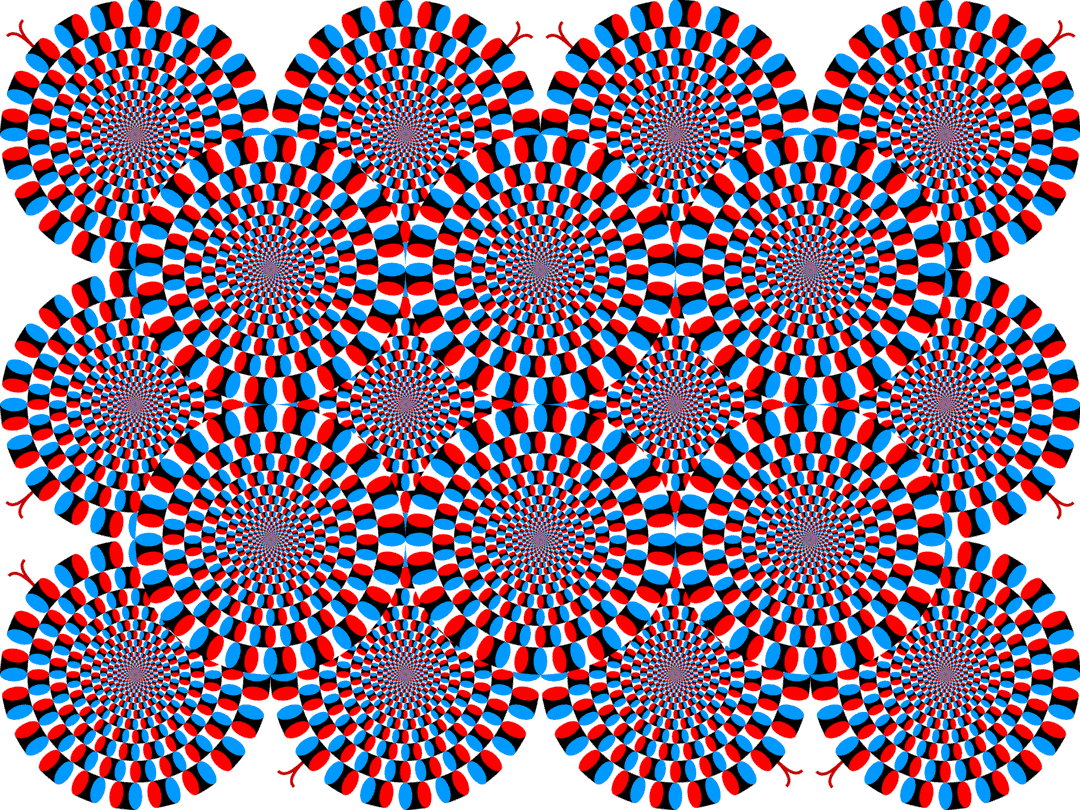
(Flash)
"On-off rotating snakes: red and sky blue #2"
When fading in, each disk appears to rotate in the direction: black, sky blue, white, red, black. The direction is reversed when fading out.
Copyright Akiyoshi Kitaoka 2013 (April 30) (GIF July 15, 2014)
Central drift illusion
Illusory motion is observed in the direction from parts of lower-contrast to parts of higher-contrast.
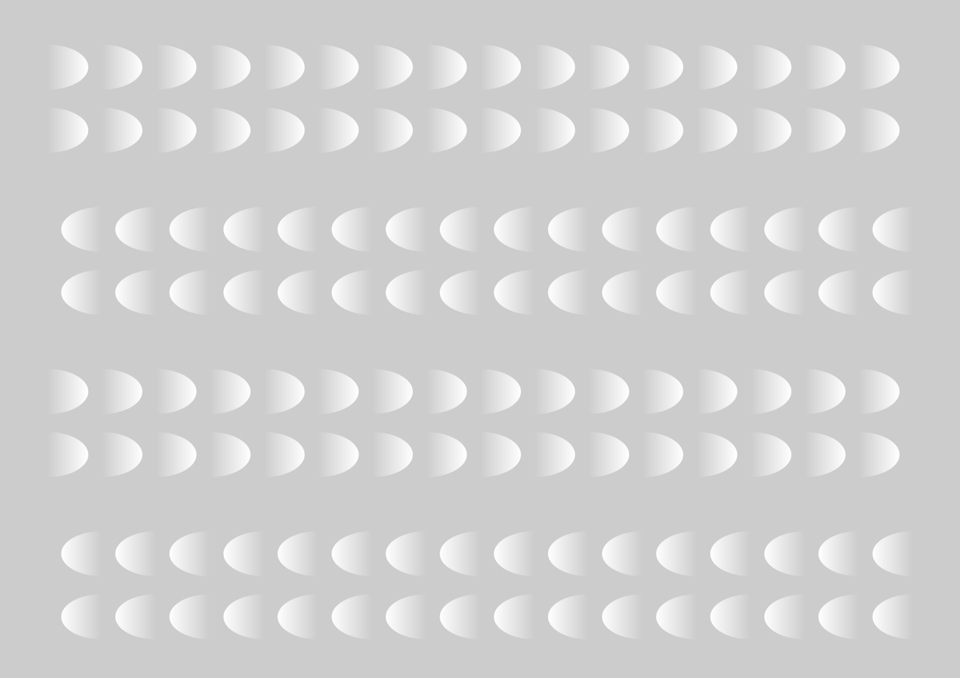
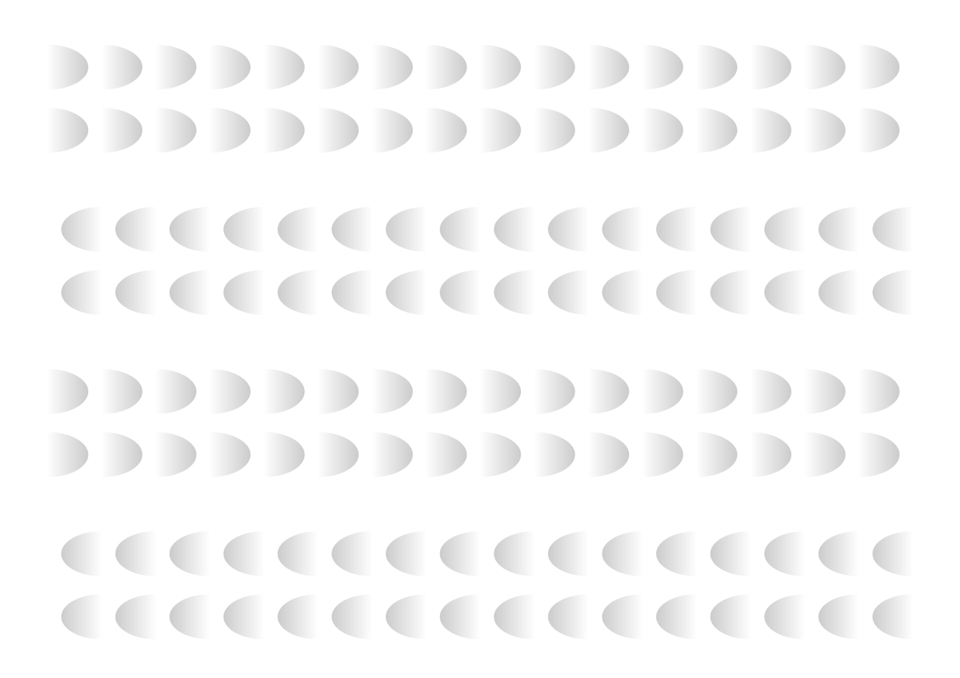
Kitaoka, A. and Ashida, H. (2004). A new anomalous motion illusion: the "central drift illusion". The 2004's winter meeting of the Vision Society of Japan at the Kogakuin University, Shinjuku, Tokyo, Japan, 2004/1/26-28, 1/26 oral publication. Presentation (html)
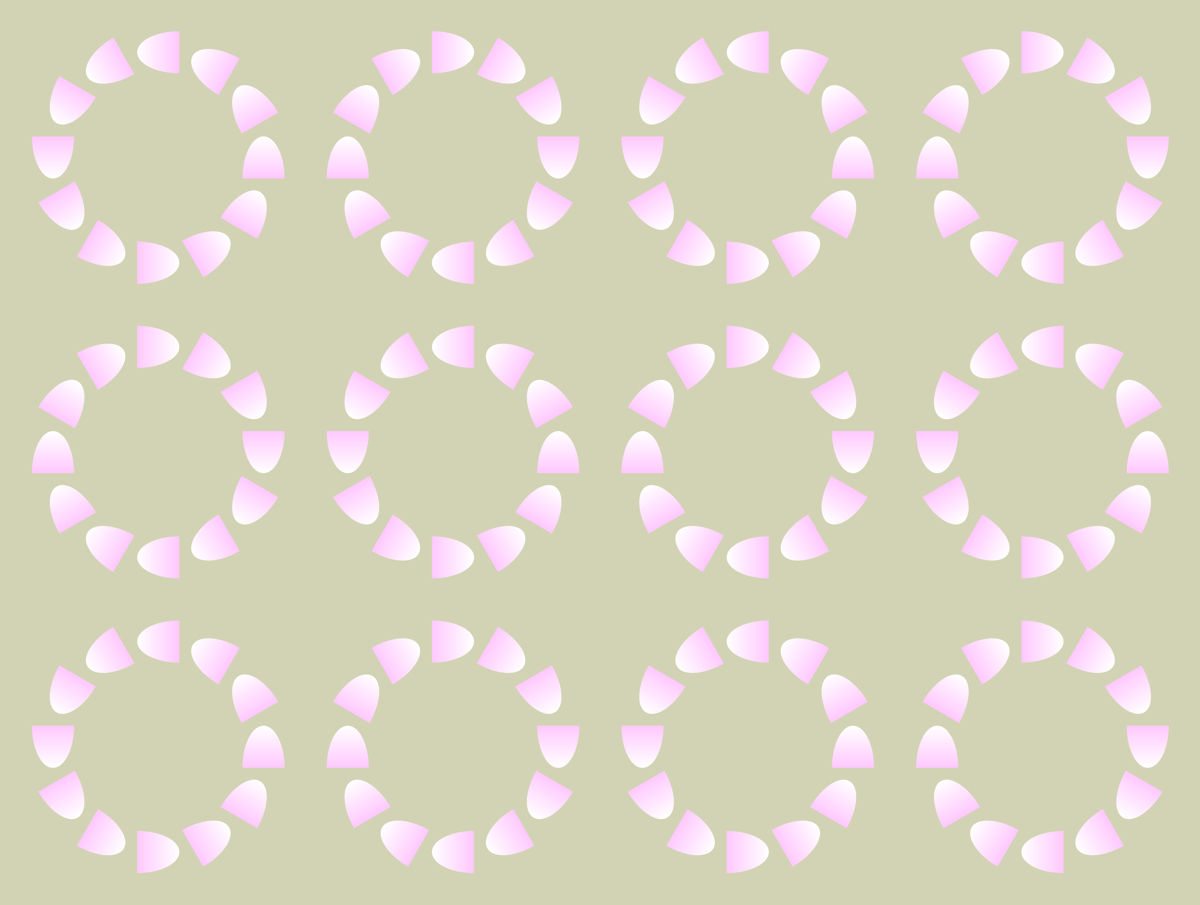
"Rotating pink boats"
Rings appear to rotate clockwise or counterclockwise moving toward each round head.
Copyright Akiyoshi Kitaoka 2016 (July 16)
Expansion illusion of visual phantoms due to the central drift illusion
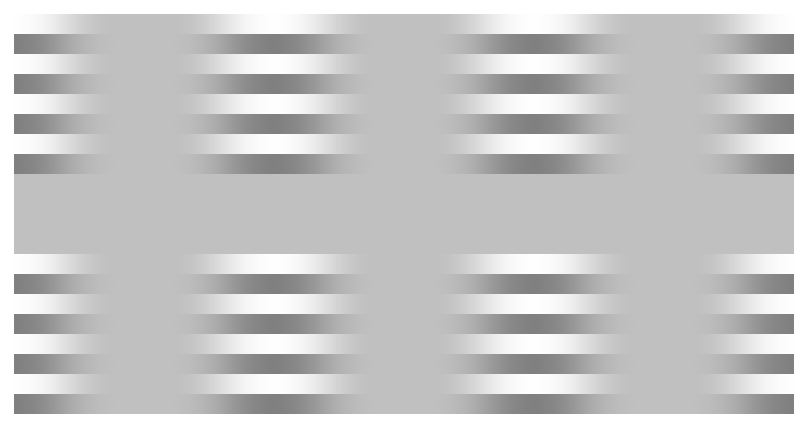
Drifting arrows illusion
Illusory motion is observed along arrows.
Type I: Arrows appear to move backward.
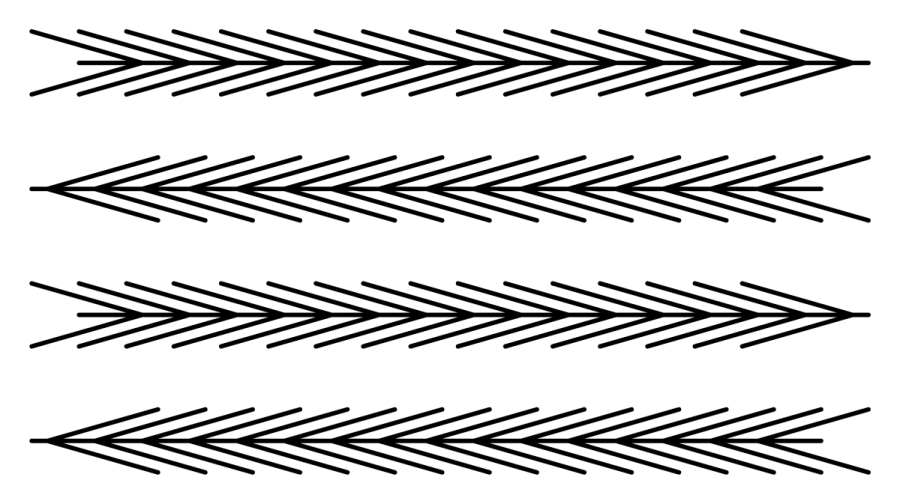
Type II: Arrows appear to move forward.
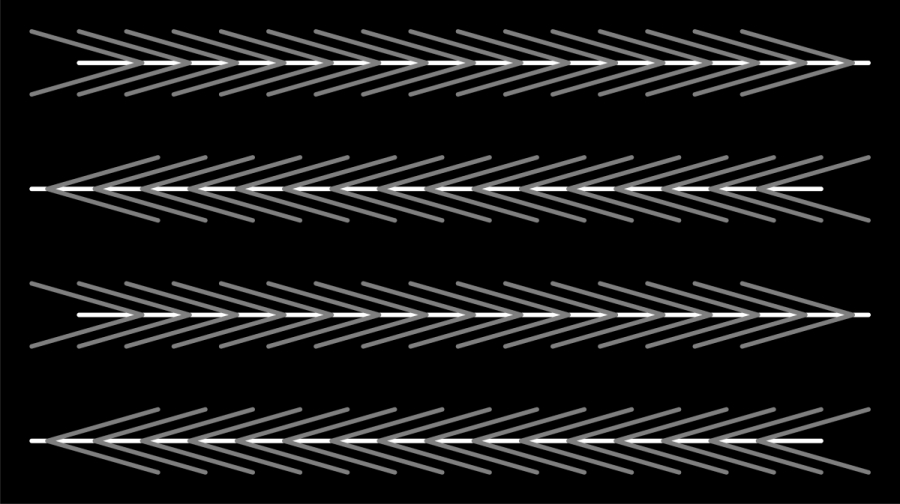
Drifting spines illusion family
The inset appears to move depending on smooth motion of retinal images.
"Drifting spines illusion"
The inset appears to move. The inset is a square but verticals appear to tilt clockwise and horizontals appear to tilt clockwise.
Copyright Akiyoshi Kitaoka 2010 (July 6)
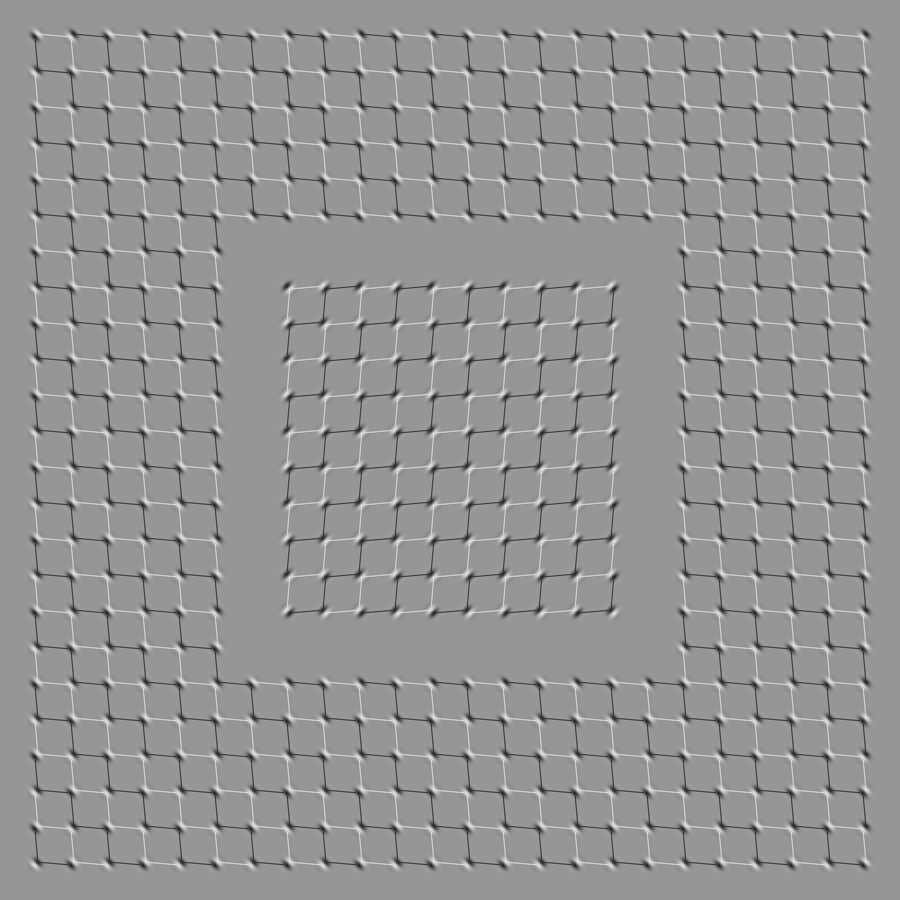
"Drifting Emboss illusion"
(sine type)
The inset appears to move.
Copyright Akiyoshi Kitaoka 2016 (February 15)
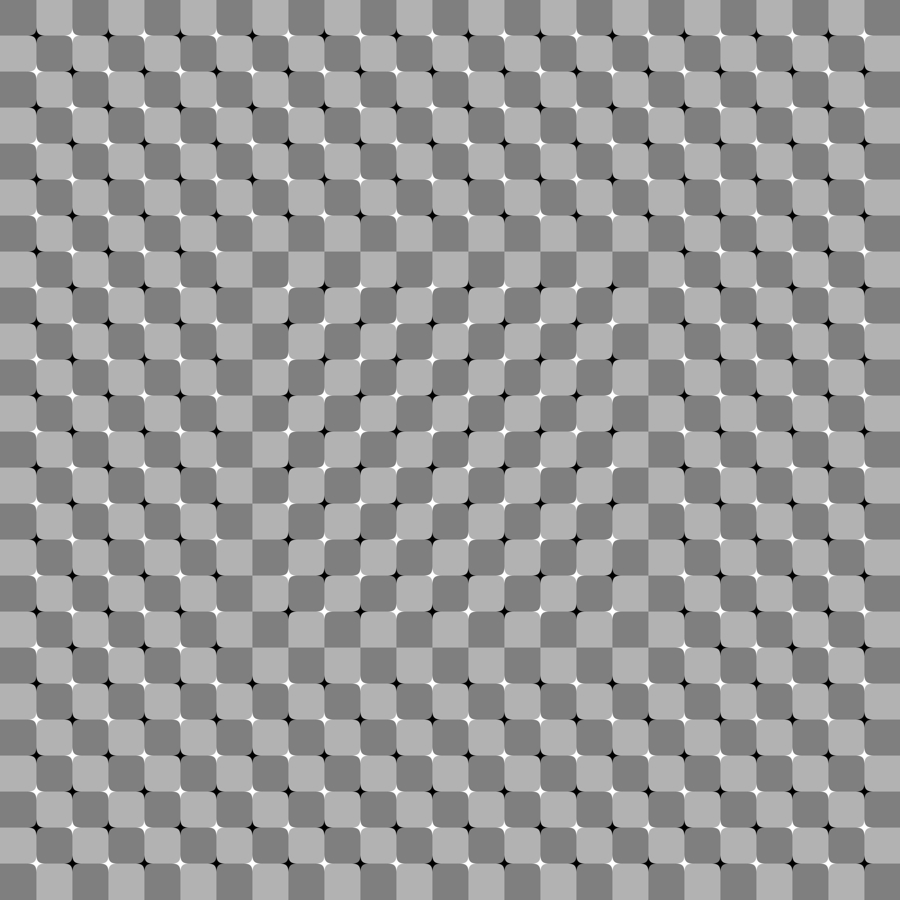
"Illusion of Y-junctions"
The inset appears to move.
Copyright Akiyoshi Kitaoka 2016 (July 16) (originally before 2000)
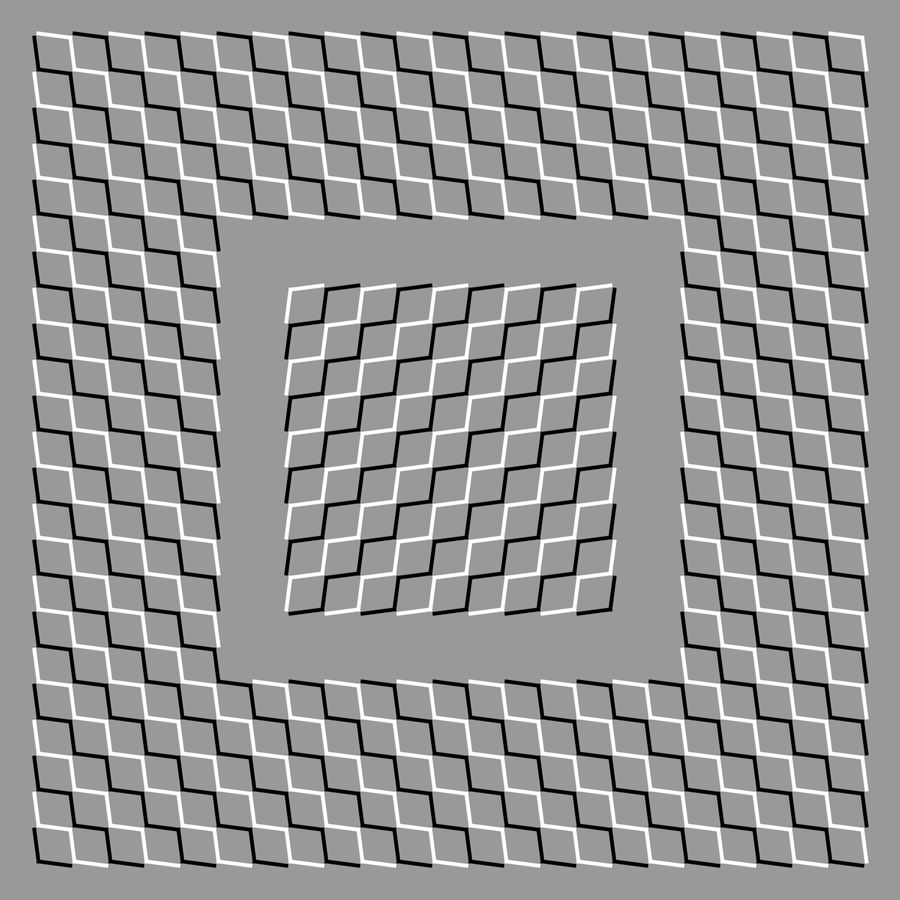
"Fraser illusion as a motion illusion"
The inset appears to move.
Copyright Akiyoshi Kitaoka 2016 (July 16)
Phenomena
These images simultaneously show motion illusion and tilt illusion.
Explanation
I attribute this coexistence to 4-stroke motion and 4-stroke tilt illusion.
Kitaoka, A. (2010). The Fraser illusion family and the corresponding motion illusions. 33rd European Conference on Visual Perception (ECVP 2010), EPFL, Lausanne, Switzerland, 2010/8/22-26, 8/26 poster publication. Poster (Kitaoka, A. (2010) The Fraser illusion family and the corresponding motion illusions. Perception, 39, Supplement, #61, p. 178)
As tilt illusion, the Fraser illusion family consists of six (3 x 2) illusions.
There are eight fundamental combinations of basic components.
(The limiting case of the Fraser illusion family)
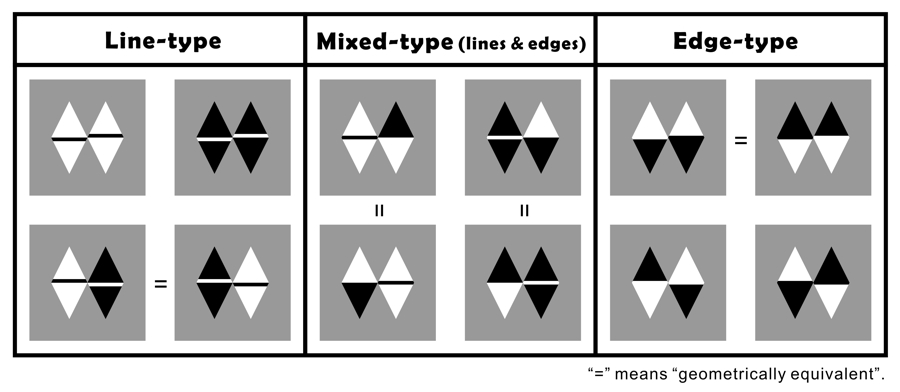
In each gray square, the middle line or edge appears to tilt counterclockwise.
These elements are shared with motion illusions in stationary images such as the drifting embosses illusion.
4-stroke motion corresponding to the Line Type
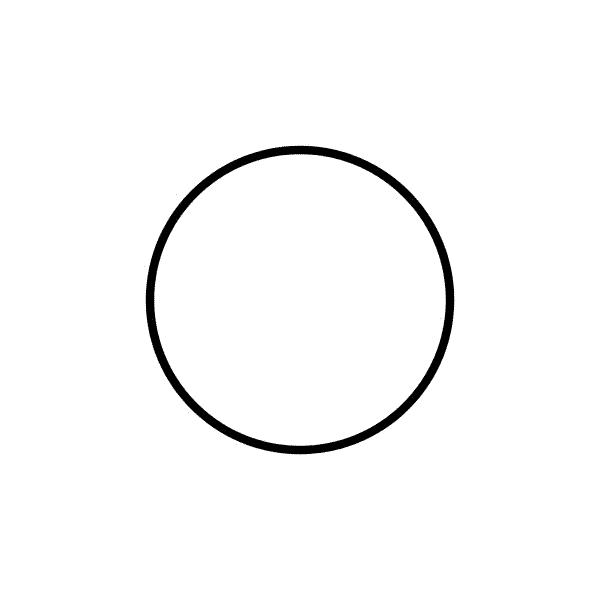
Copyright Akiyoshi Kitaoka 2010 (March 22)
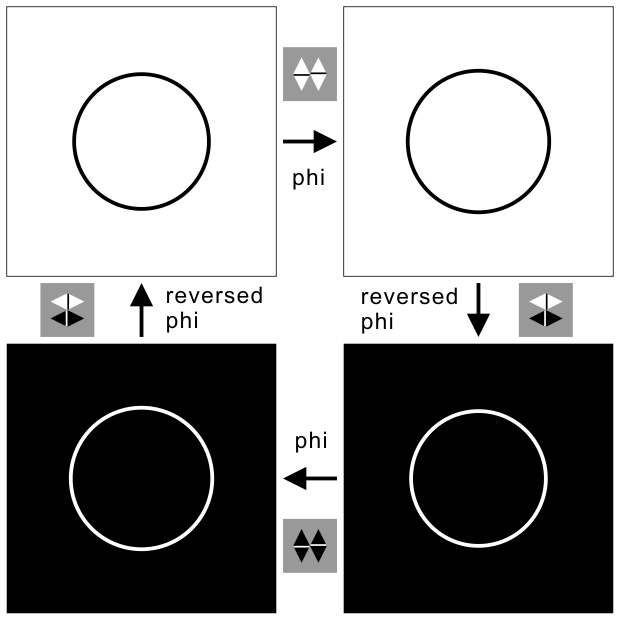
Finding: The direction of motion is the same as the tilt illusion.
Mather, G. and Murdoch, L. (1999) Second-order processing of four-stroke apparent motion. Vision Research, 39, 1795-1802.
cf. van Lier R, Csathó Á, 2005 “Dancing shapes: A comparison of luminance induced distortions” Perception, 35, 775 – 798.
4-stroke motion corresponding to the Edge Type
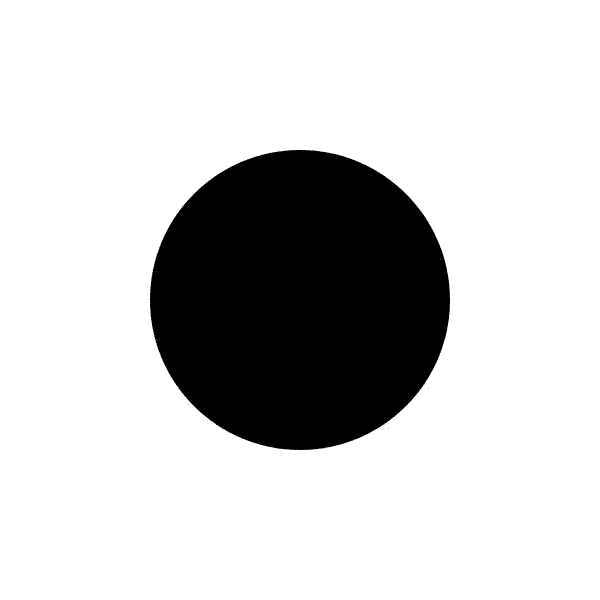
Copyright Akiyoshi Kitaoka 2010 (March 22)
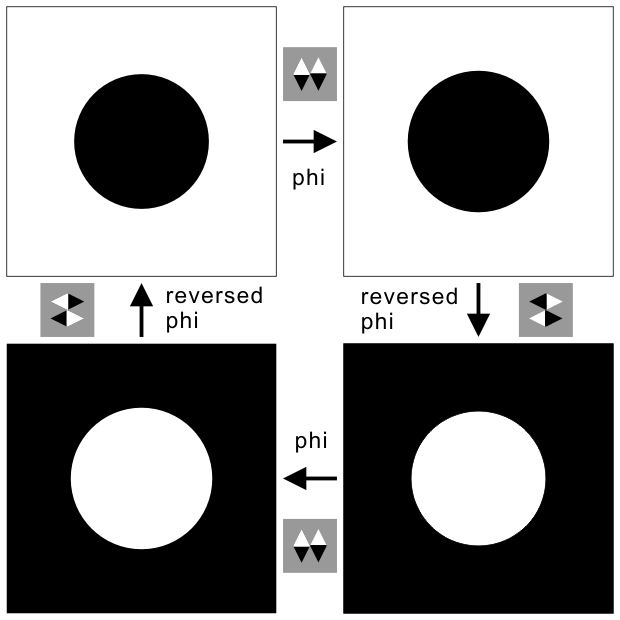
Finding: The direction of motion is the same as the tilt illusion.
cf. van Lier R, Csathó Á, 2005 “Dancing shapes: A comparison of luminance induced distortions” Perception, 35, 775 – 798.
4-stroke motion corresponding to the Mixed Type
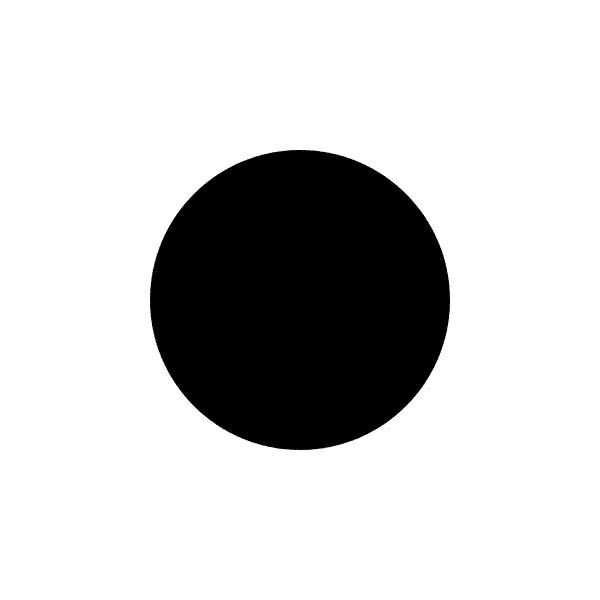
Copyright Akiyoshi Kitaoka 2010 (March 22)
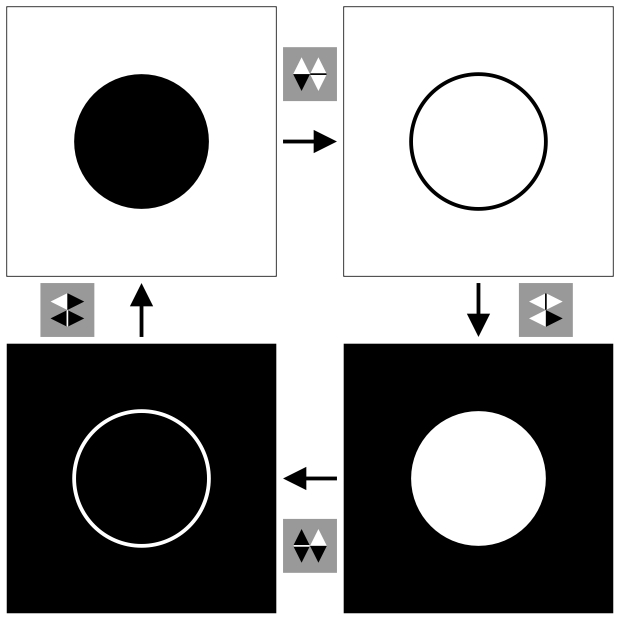
Finding: The direction of motion is the same as the tilt illusion.
<Takeuchi's four-stroke motion>
Takeuchi, T. (1997) The motion analogue of the cafe wall illusion. Perception, 26, 569-584.
Then, anomalous motion illusions that coexist in tilt illusion images can be explained in this context.
When the retinal image slides in the special direction, the four-stroke motion is generated and motion illusion is observed.
Example
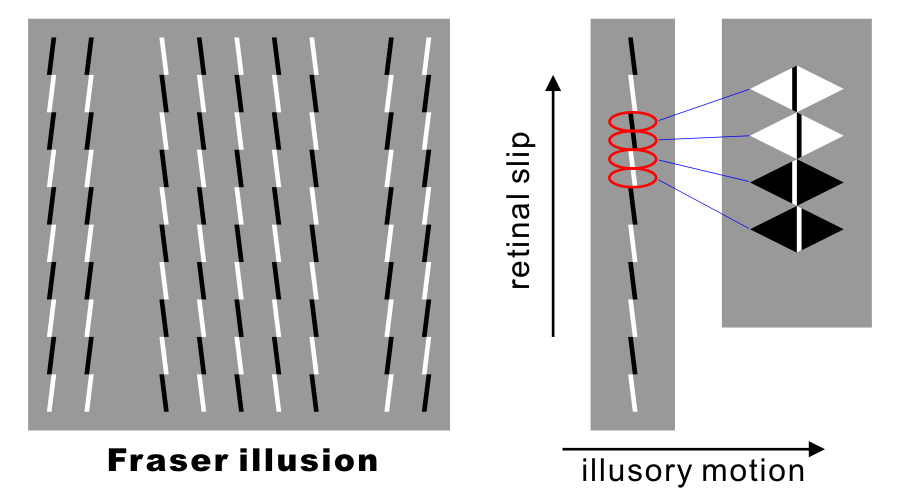

Example
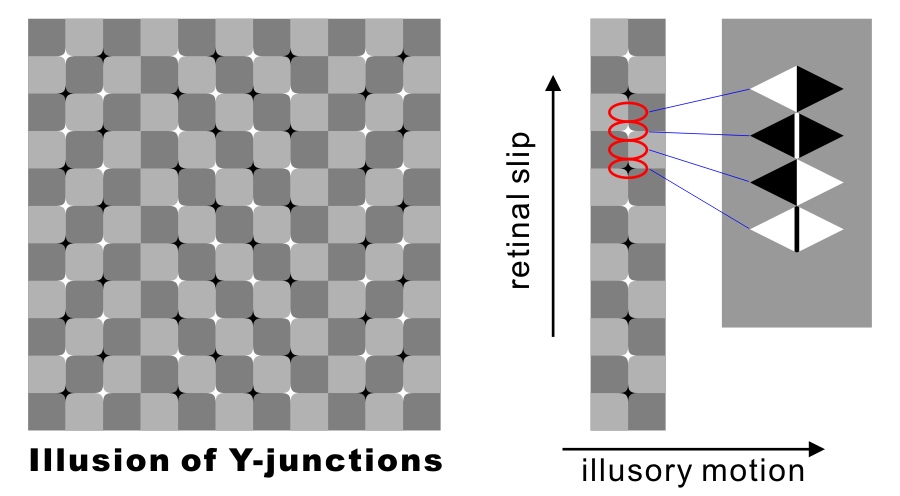
Drawn by Aliyoshi Kitaoka 2010 (June 25)

(Takeuchi's four-stroke motion)
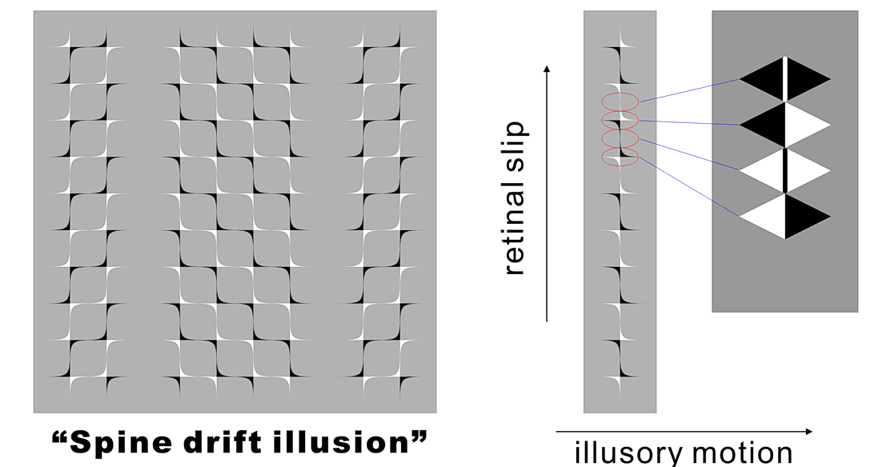
Visual delay illusion
When retinal images are moved, parts of low-contrast and/or low-luminance (inset) appear to move due to visual delay against parts of high-contrastand/or low-luminance (surround).
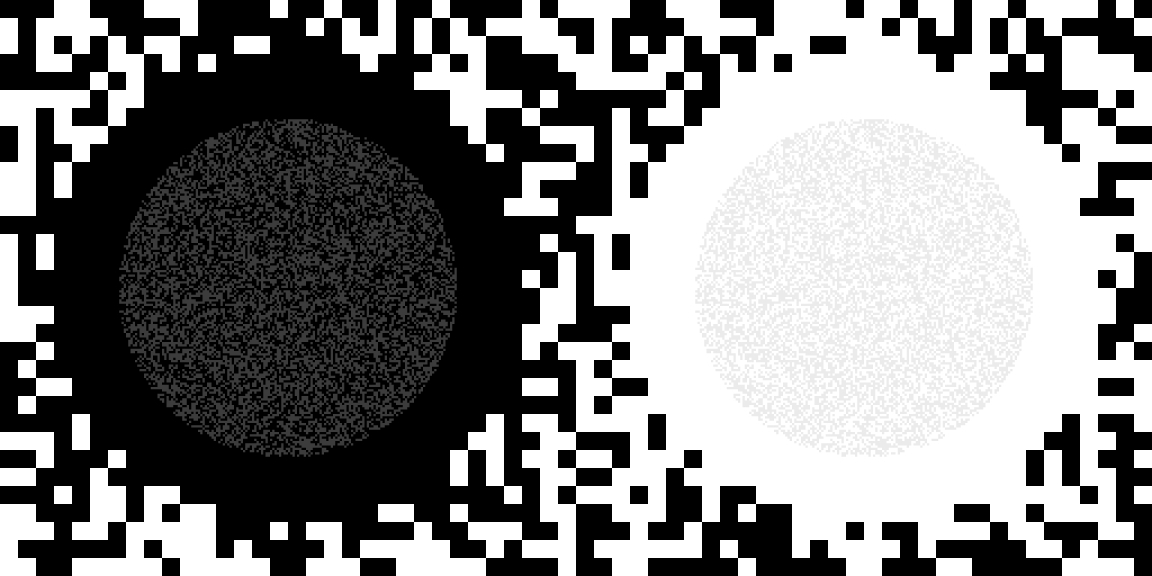
Kitaoka, A. and Ashida, H. (2007). A variant of the anomalous motion illusion based upon contrast and visual latency. Perception, 36, 1019-1035.
Enhanced version of the fluttering heart illusion
When retinal images are moved, hearts appear to move.
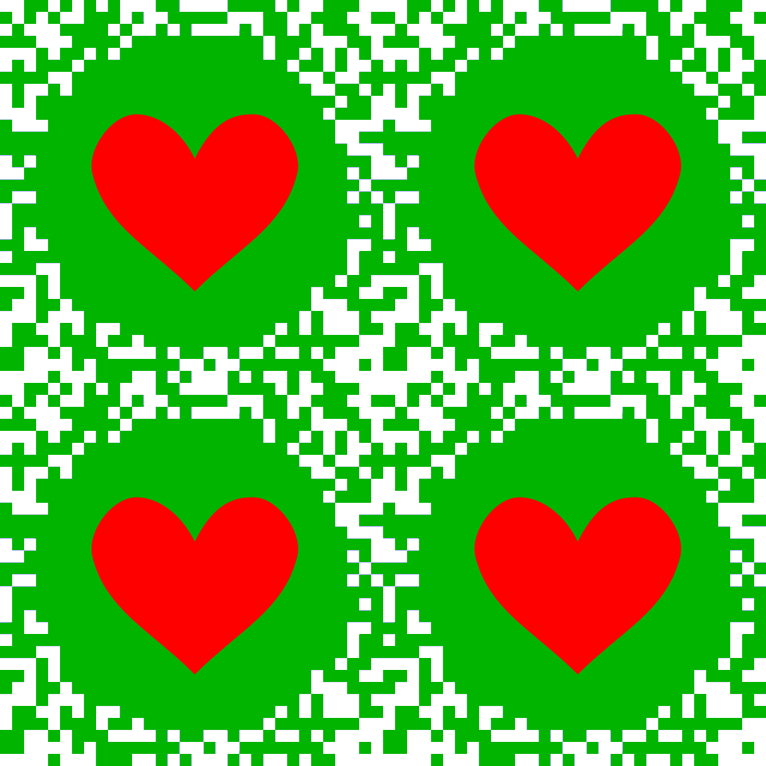
Other illusions depending on retinal motion
Differences of spatial frequency generate motion illusion.
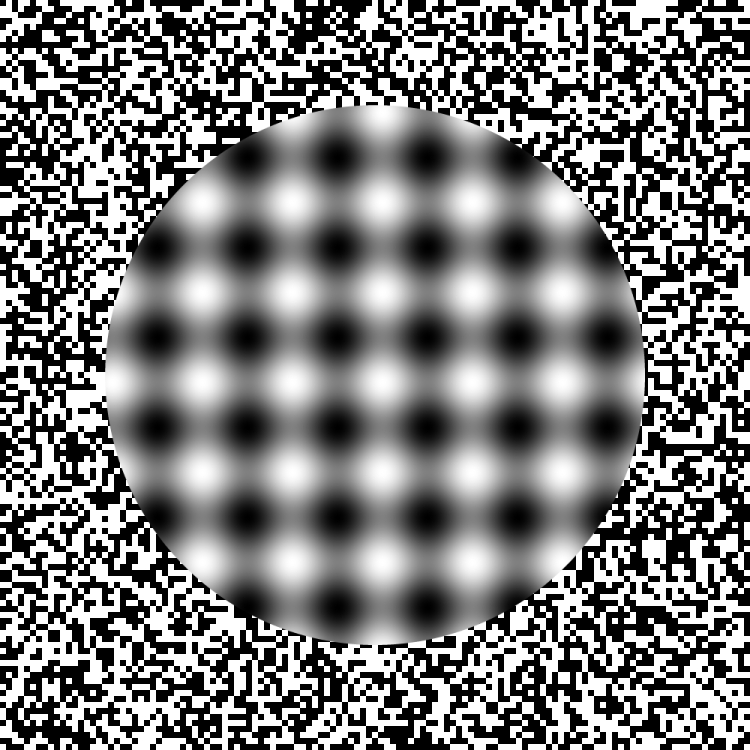
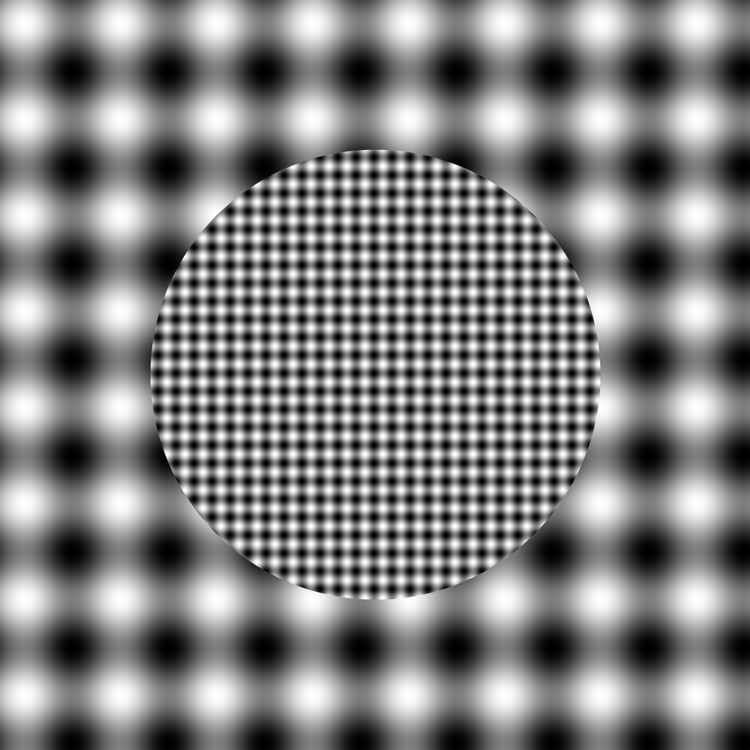
Drifting stripes illusion
Illusory motion is triggered by eye movement, blinks, or some events along the direction orthogonal to stripes.
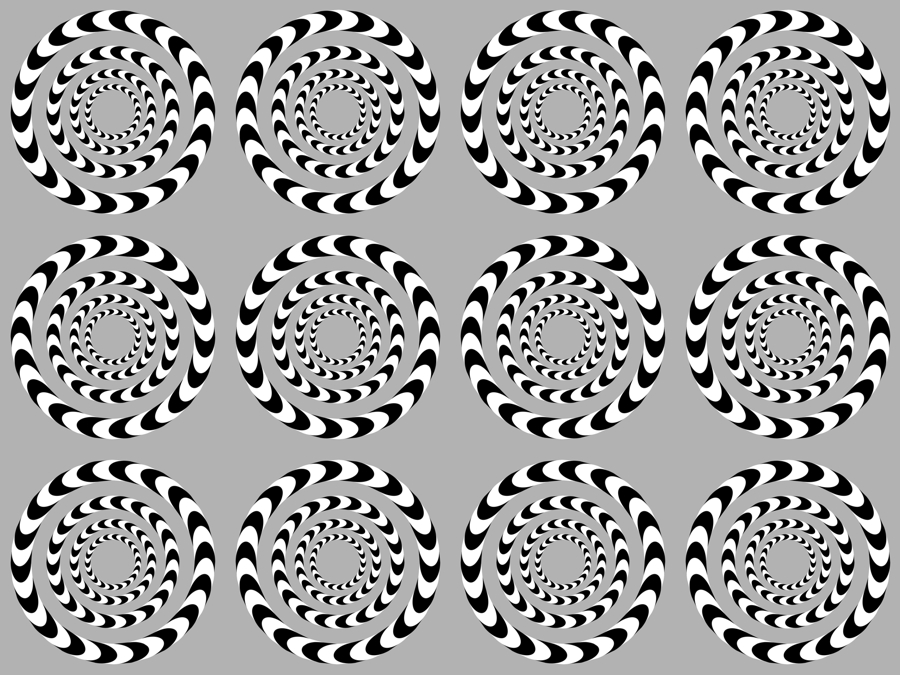
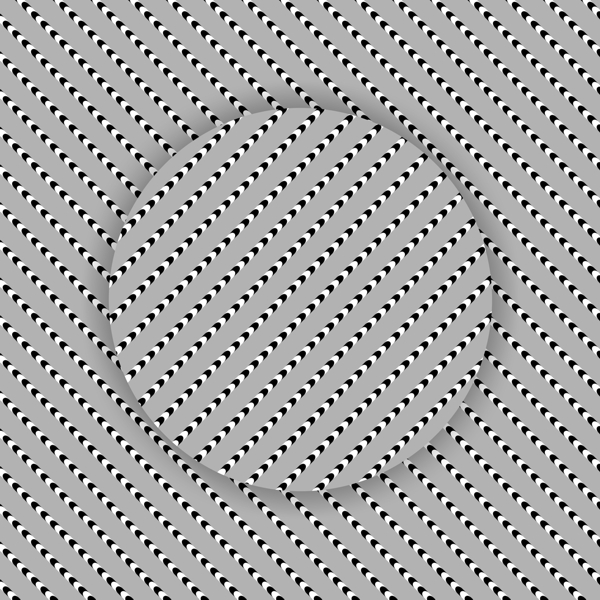
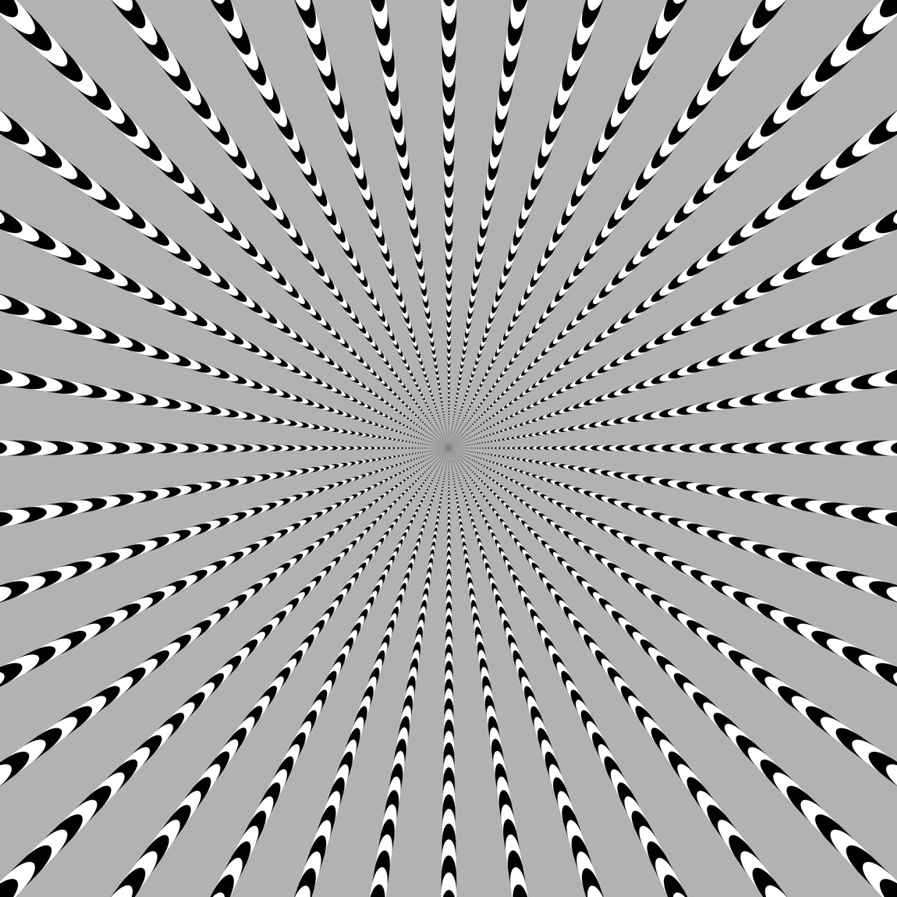
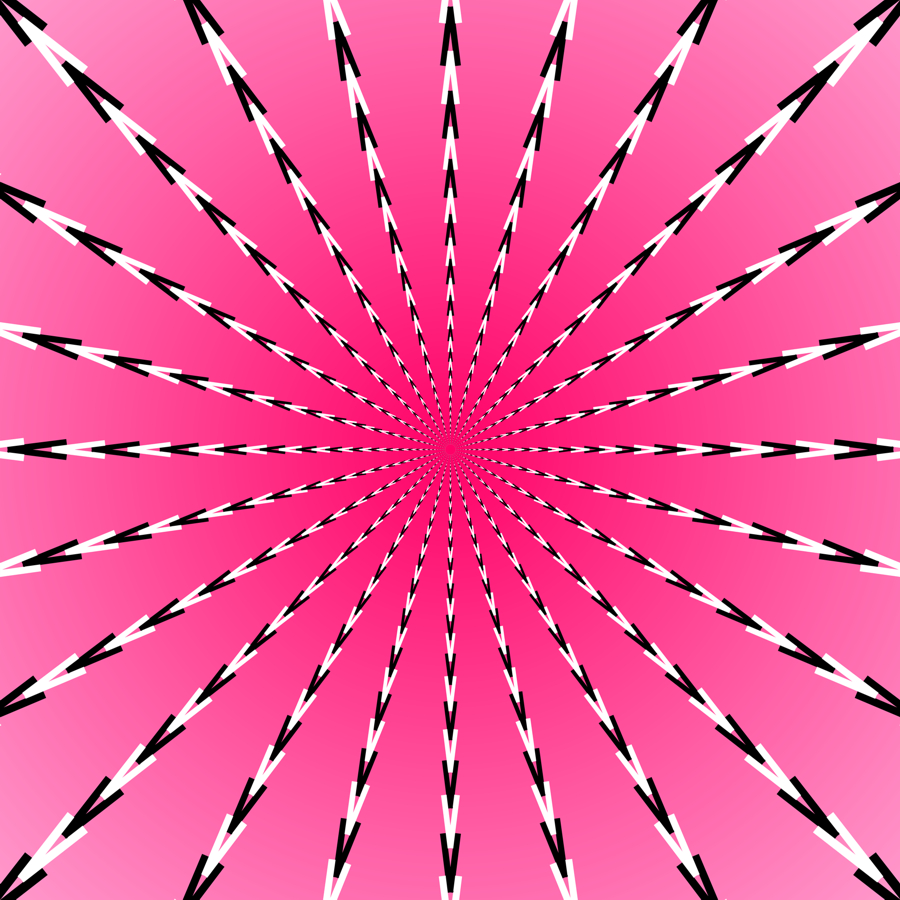
"Hatpin urchin (pink)"
The image appears to wiggle in the radial direction.
Copyright Akiyoshi Kitaoka 2013 (November 19)
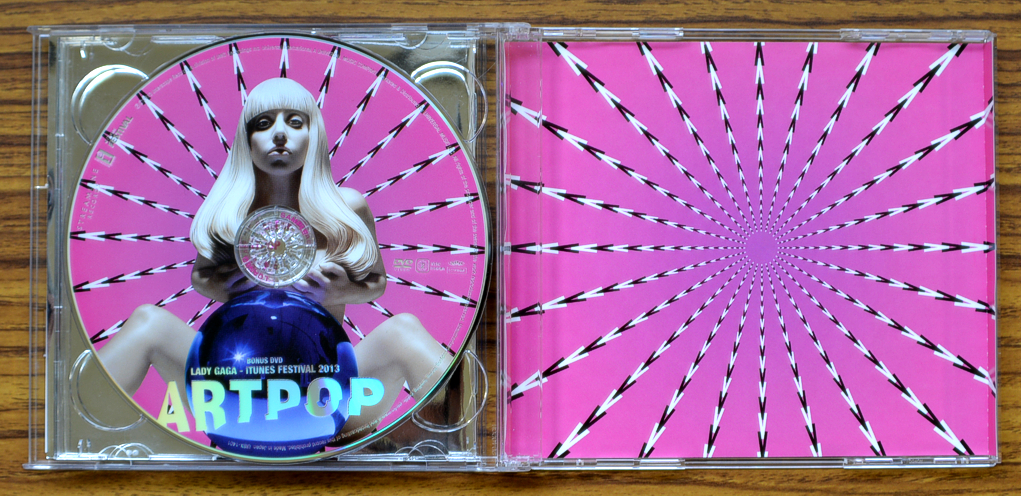
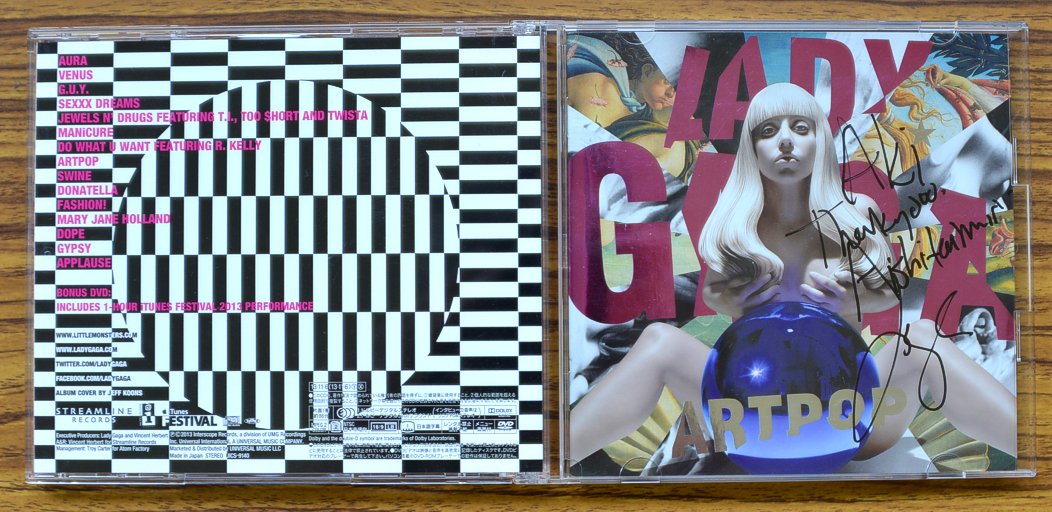
"ICP2016 motion illusion"
Words or the background appear to move.
Copyright Akiyoshi Kitaoka 2011 (August 1)
Continuation between the Ouchi illusion and the drifting stripes illusion
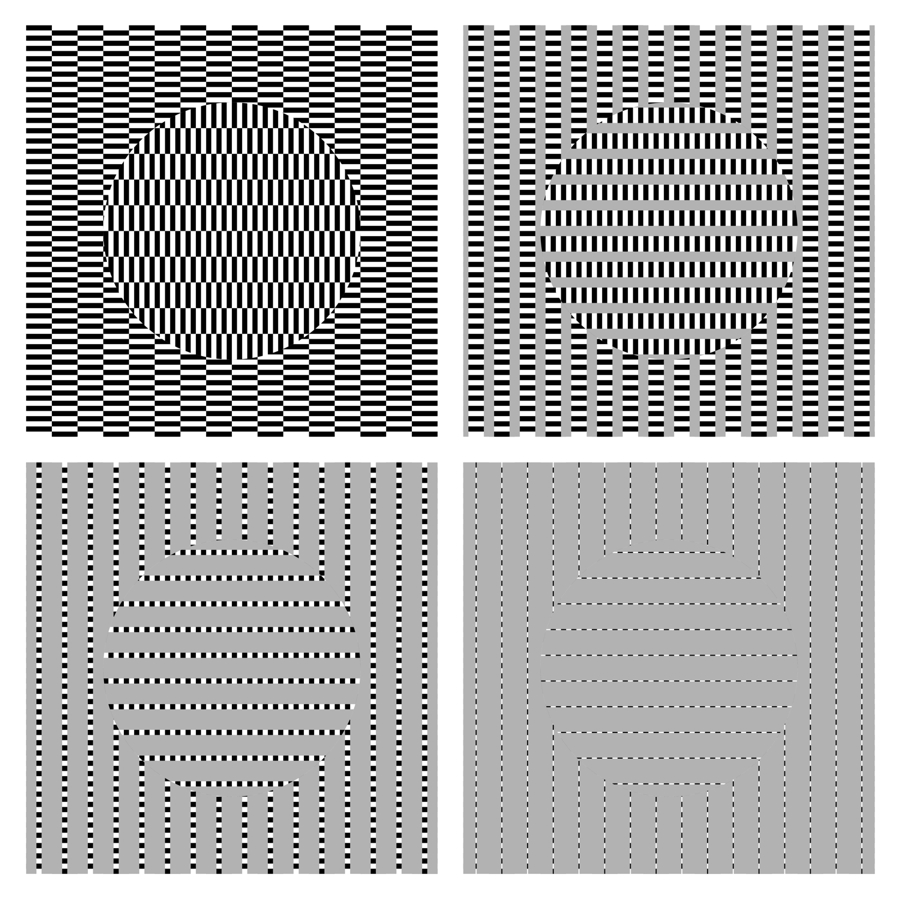
Op effect
So-called op effect can be include in motion illusion in stationary images.
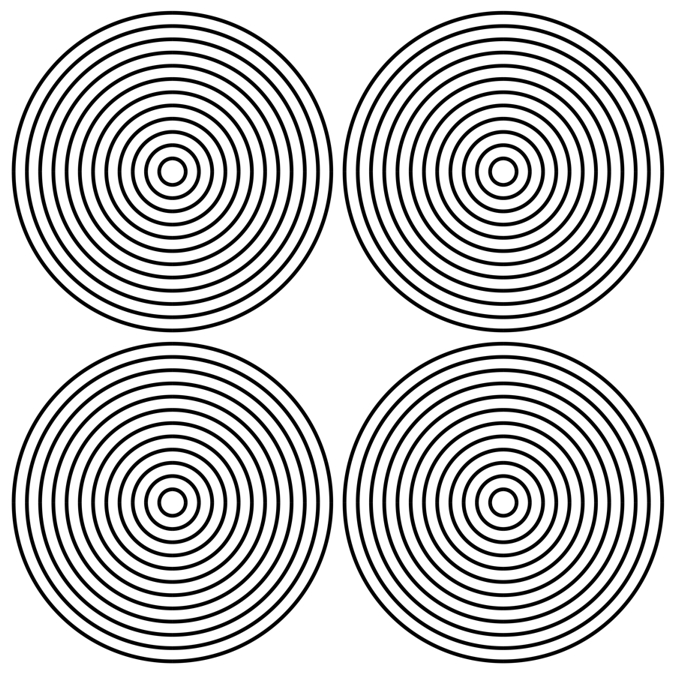
Illusory radials appear to rotate.
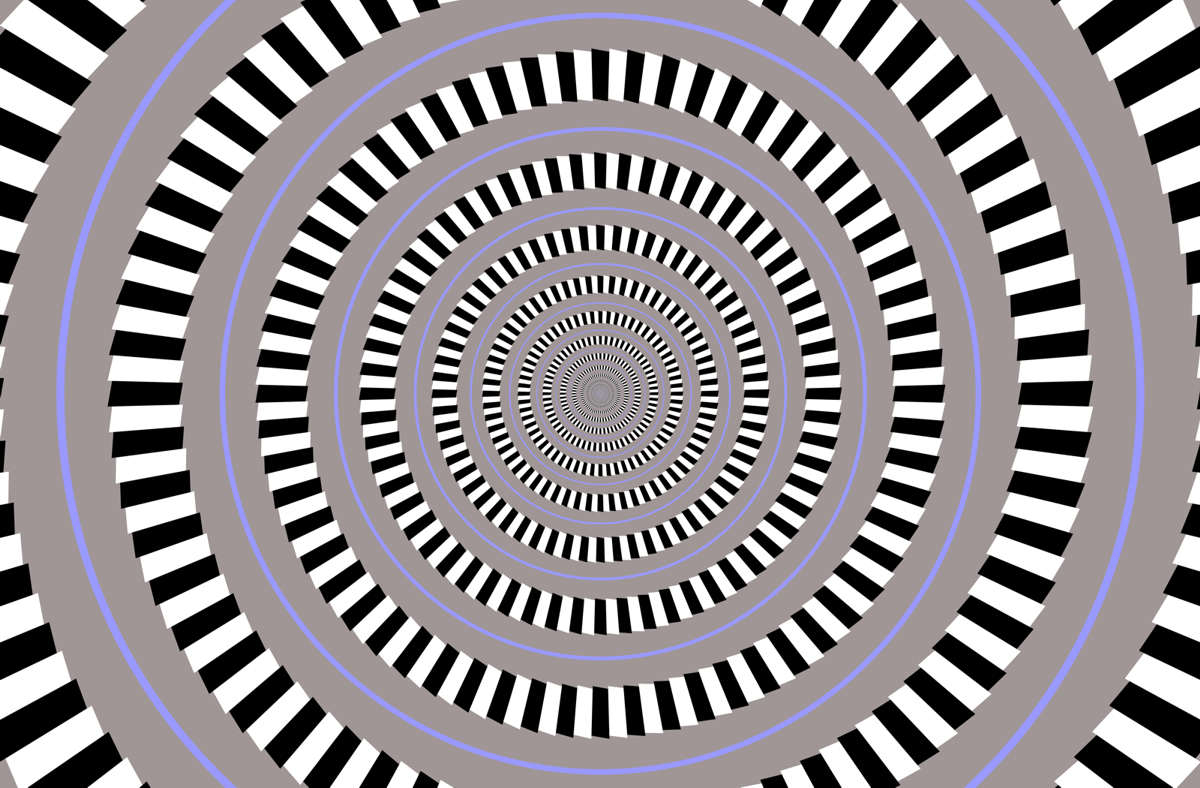
Something appears to rotate quickly along blue circles (Enigma illusion).
Enigma illusion: Leviant, I. (1996) Does ‘brain-power’ make Enigma spin? Proceedings of the Royal Society of London, B, 263, 997-1001.
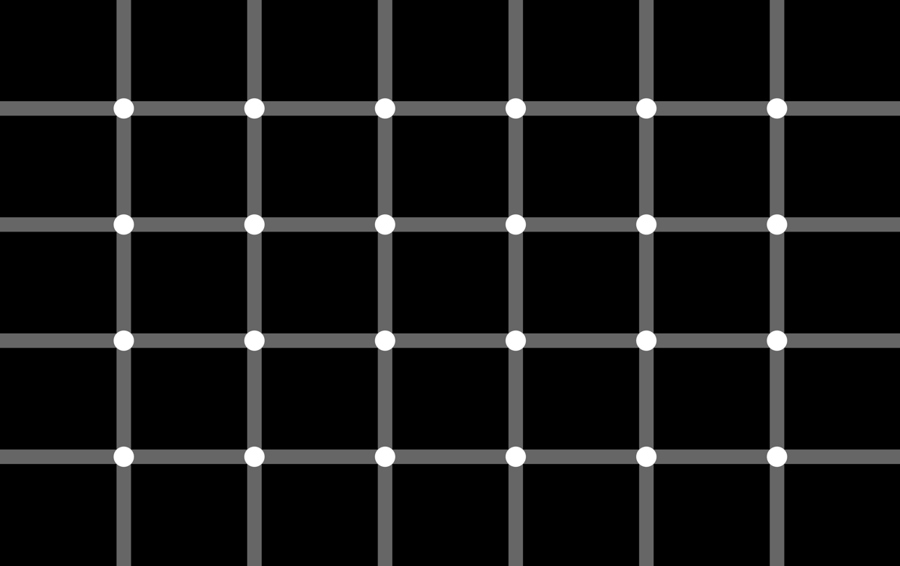
Scintillating grid illusion (Schrauf et al, 1997)
Schrauf, M., Lingelbach, B., Wist, E. R. (1997) The scintillating grid illusion. Vision Research, 37, 1033-1038.
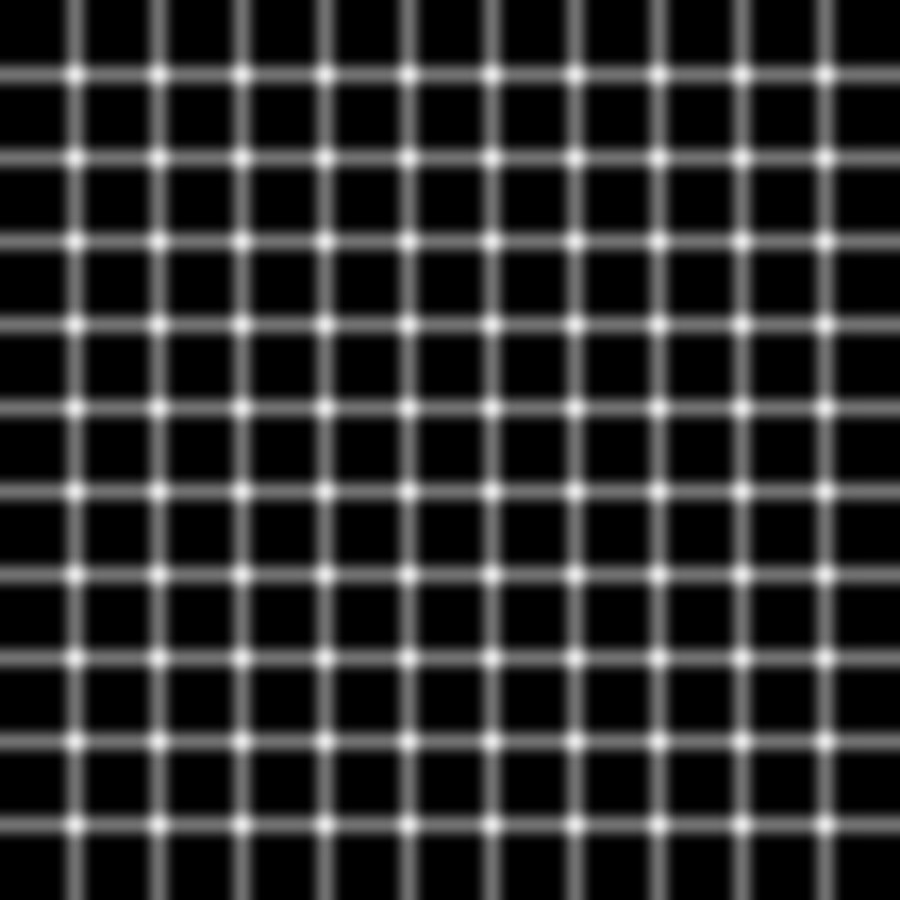
Bergen grid illusion (Bergen, 1985)
Bergen, J. R. (1985). Hermann's grid: new and improved (abstract). Investigative Ophthalmology and Visual Science (Supplement), 26, 280.
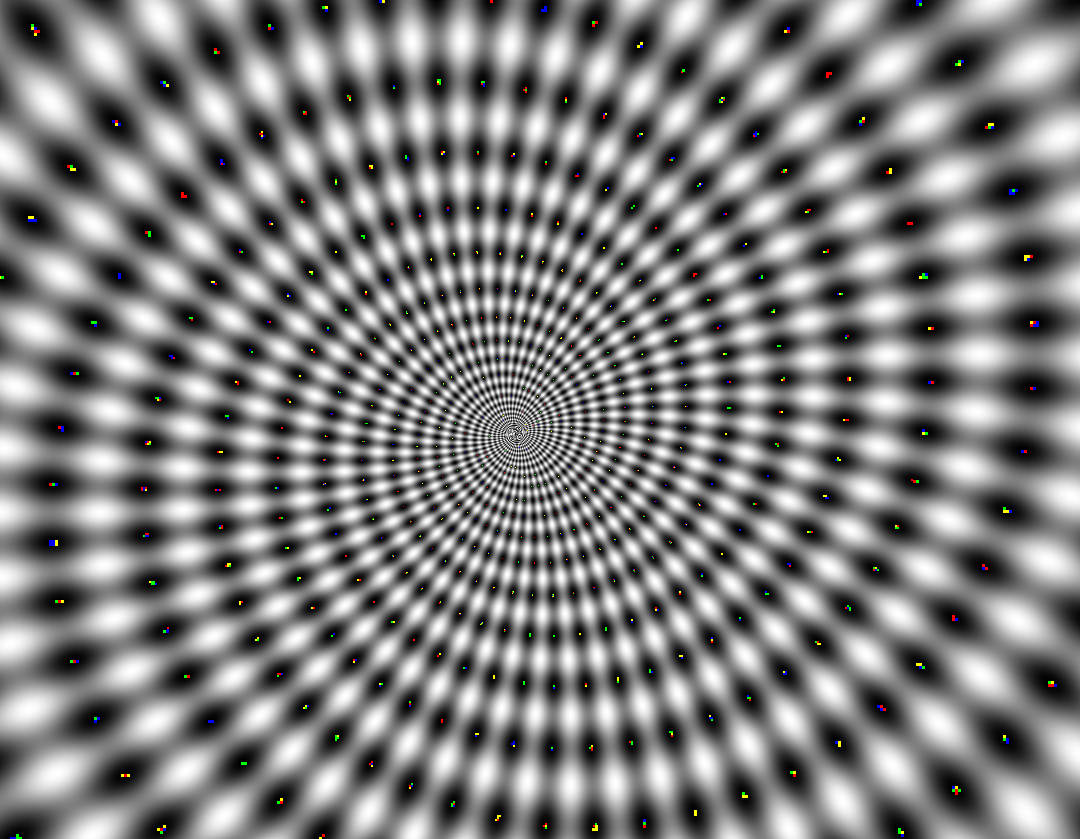
Color grains appear to scintillate.
As global motion, there is
waving expression of motion illusion
in addition to parallel motion, rotation or radial motion.
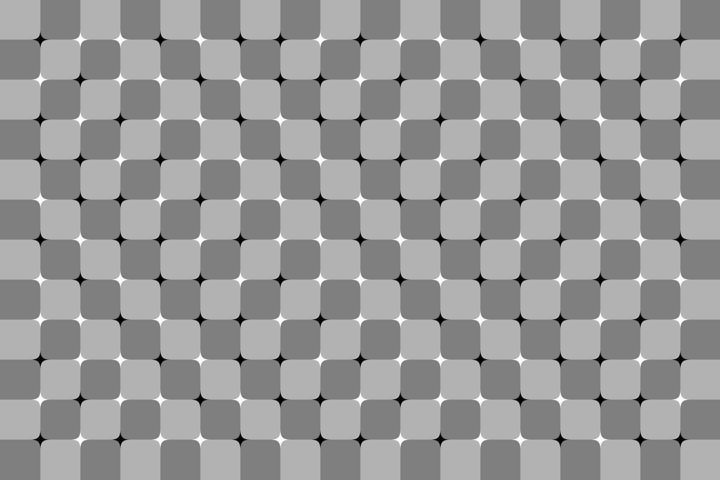
Illusion of Y-junctions
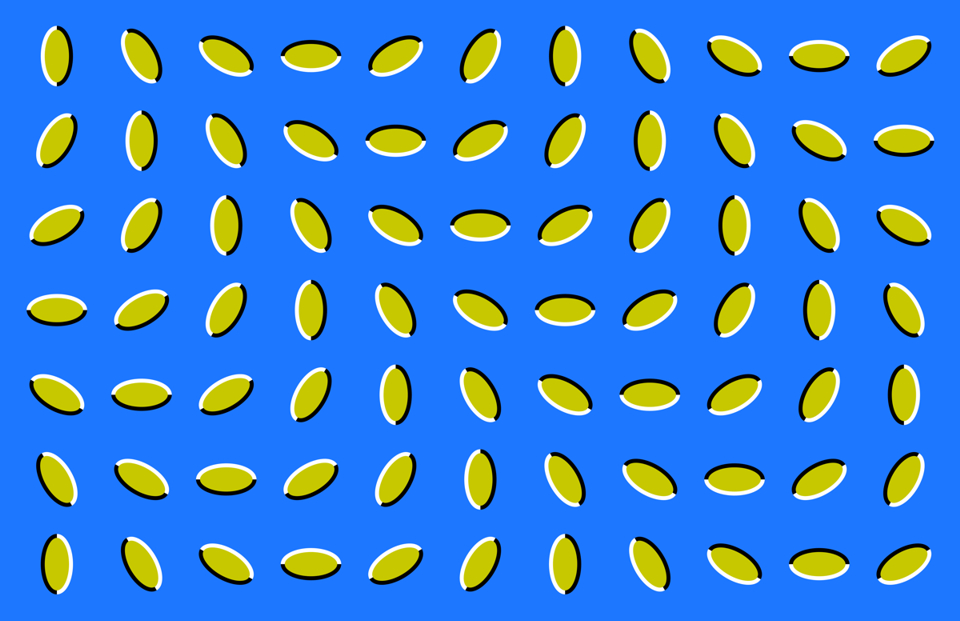
Optimized Fraser-Wilcox illusion, Type IIa
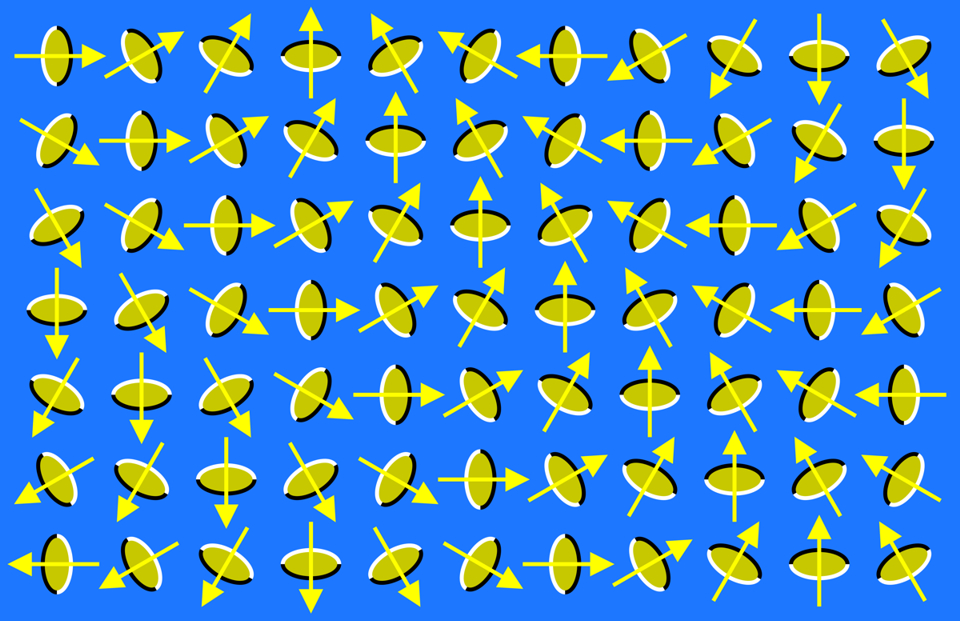
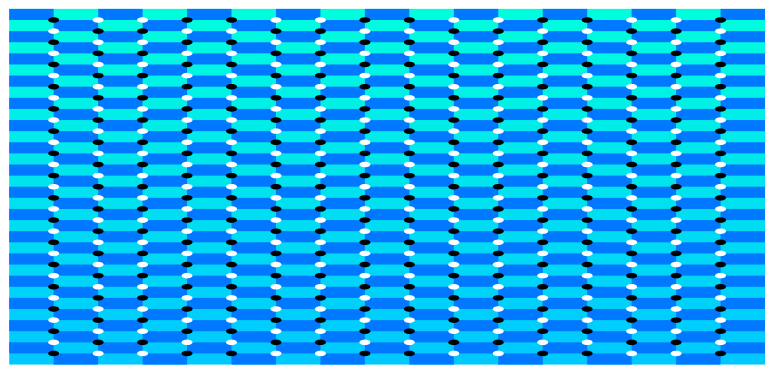
"The bottom of the sea"
The image appears to wave.
Copyright Akiyoshi Kitaoka 2005 (April 15)
Abstract
Motion illusions in stationary images are classified into three major categories
depending on whether the illusory motion is rendered (1) by retinal motion
of the image, (2) along particular repetitive patterns, or (3) by other
factors. The first category consists of two subcategories, one showing
illusory motion in the same direction as retinal motion (e.g., fluttering
heart illusion) and the other displaying it in different directions (e.g.,
drifting spines illusion). The second category includes the extended family
of the Fraser-Wilcox illusion that is characterized by strong illusion
in the peripheral vision and no illusion in the central vision (e.g., Rotating
snakes illusion). There are other types that show illusion in the central
vision as well (e.g., drifting arrows illusion). The third category includes
a variety of op effects (e.g., scintillating grid illusion). The roles
of color, eye movements or adaptation levels in these illusions are discussed.
Thank you !
IA28-12 Sensation and Perception
Thursday, July 28, 11:30 – 12:10
Conference Center 4F 419
Motion illusions in stationary images
Kitaoka, Akiyoshi (Japan)
Introduction by Sakurai, Kenzo